Connecticut State Police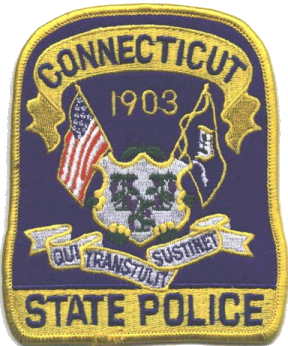
Connecticut State Police
On May 29, 1903, the Connecticut State Police was founded, thus the Centennial Celebration for this pioneer state law enforcement agency was in 2003.
Five state police commissioners were appointed to lay the groundwork for the first state police department. In October of the same year, Thomas F. Egan was named the agency's first superintendent. He was empowered to appoint the first state police officers. He chose five and their primary duties were to enforce laws pertaining to intoxicating liquor and gaming violations as were the mandates of most early state police agencies at the time.
By 1913, the department numbered 15 state police officers and in 1923 there were 80. Between 1921 and 1924, seven barracks were established outside of Hartford with one or two officers manning each of these "sub-stations."
During the 1940's, the CSP embarked on a public relations campaign and used clearly-marked cruisers to remind motorists of police presence. The CSP divided state areas into divisions which encompassed 11 stations, and established six advanced and specialized units. The uniform was redesigned and national profile was given to the Bureau of Identification, the forerunner of the present-day, state of the art Forensics Lab.
Polygraph, Connecticut On-Line Law Enforcement Communication Teleprocessing, Canine Unit, Firearms Range, and D.A.R.E. (training of state and local officers in drug awareness) are among other features added by the department over the years.
Connecticut State Police vehicles have always been registered with regular state-issued passenger license plates for their vehicles. Commencing around 1938, the CSP began mounting title plates which read STATE over POLICE and used in conjunction with the regular state-issued plates for the patrol vehicle. These plates were made of embossed steel and measured approximately 6" by 10 1/2". They were painted red with white lettering. It is said that some of the earlier versions of these SP title plates were stamped into the reverse sides of unissued 1932-1935 passenger plates to the point where the flattened features of the original plate can be seen on the rear side of the SP plates. These plates would be the shorter 5 7/8" by 9 1/4" versions from that era.
Special steel mounting brackets and posts were used quite often and were affixed into pre-drilled holes in the vehicle's bumper or other fixtures to display the title plate prominently.
The Connecticut State Police stands alone in this unusual practice amid the other SP-HP agencies in the United States.
 1924 showing patrol car and motorcycle for Trooper George Gardner.
1924 showing patrol car and motorcycle for Trooper George Gardner.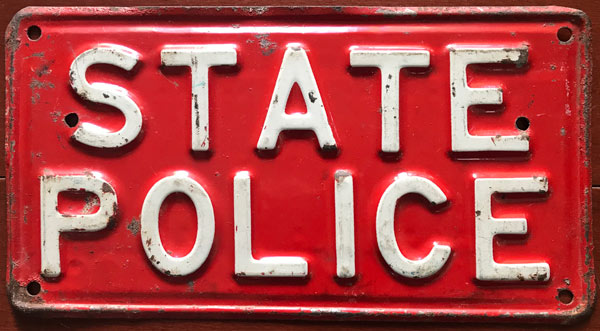 1938-1954 issue. Embossed steel. Approx. 6" x 10 1/2".
1938-1954 issue. Embossed steel. Approx. 6" x 10 1/2". 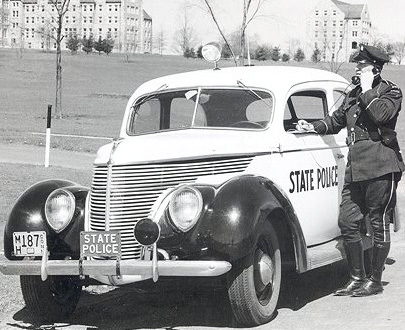
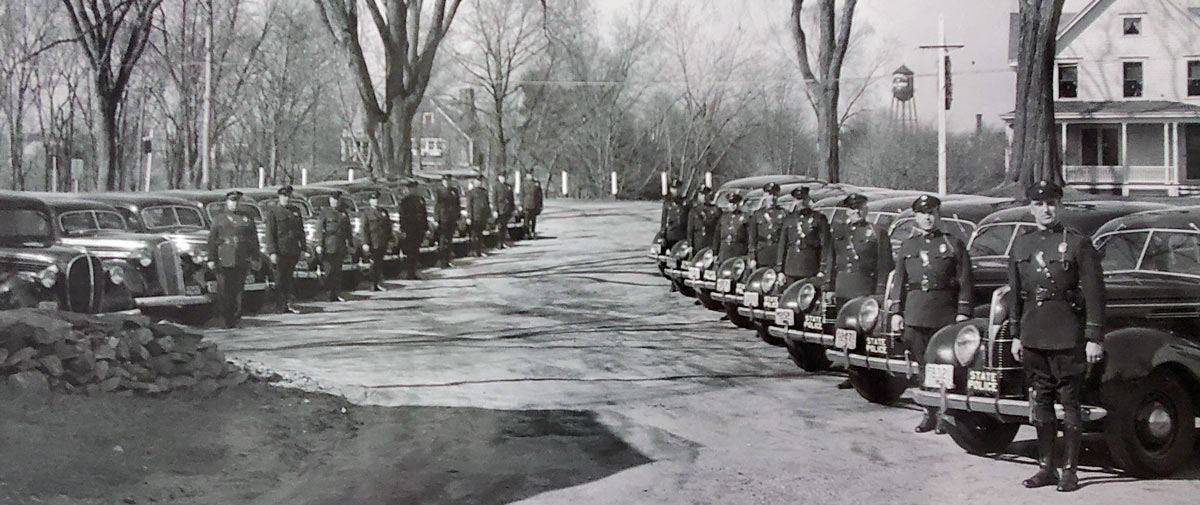 (Courtesy Nick Leary)
(Courtesy Nick Leary)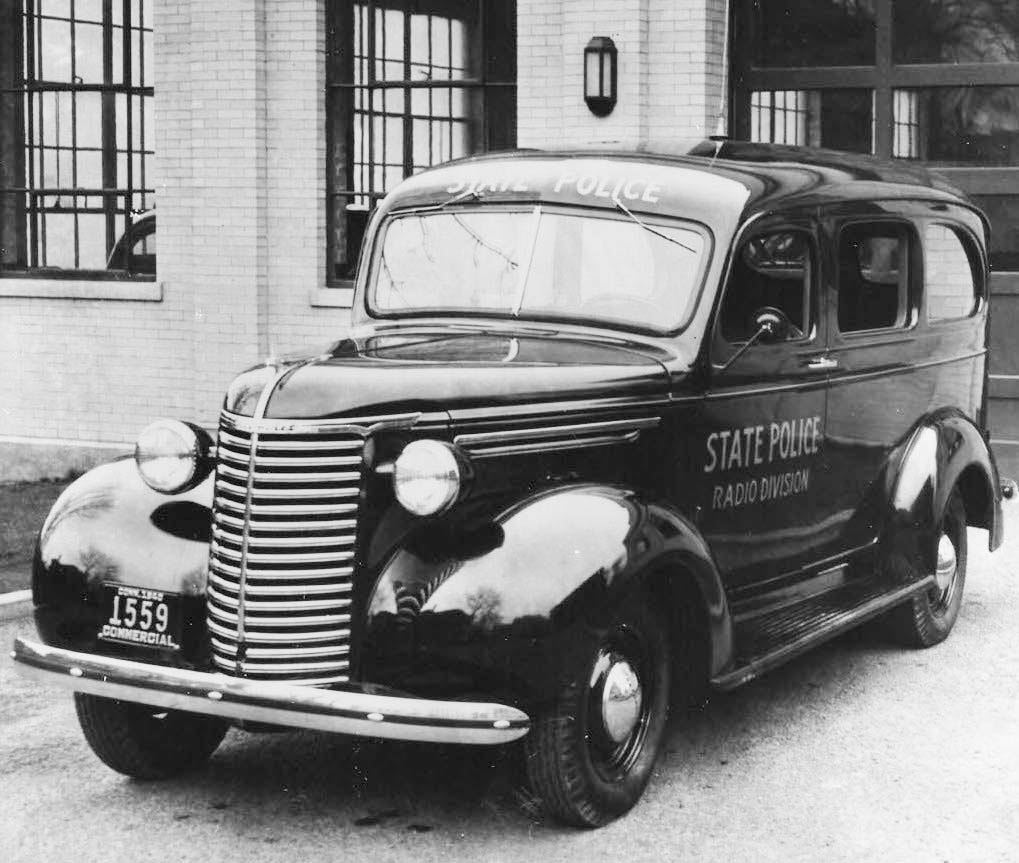 CSP Radio Division Van with 1940 Connecticut Commercial Vehicle License Plate
CSP Radio Division Van with 1940 Connecticut Commercial Vehicle License Plate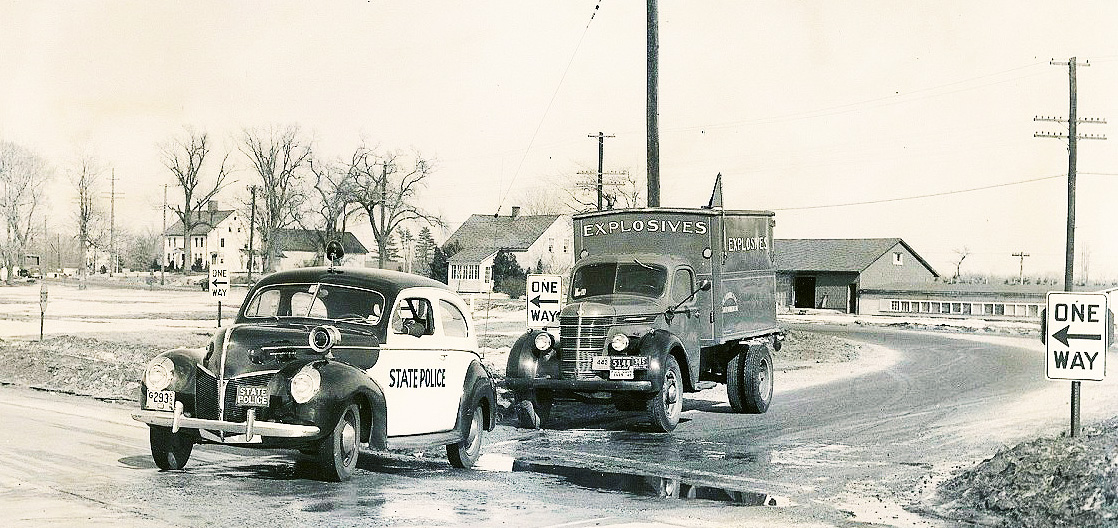
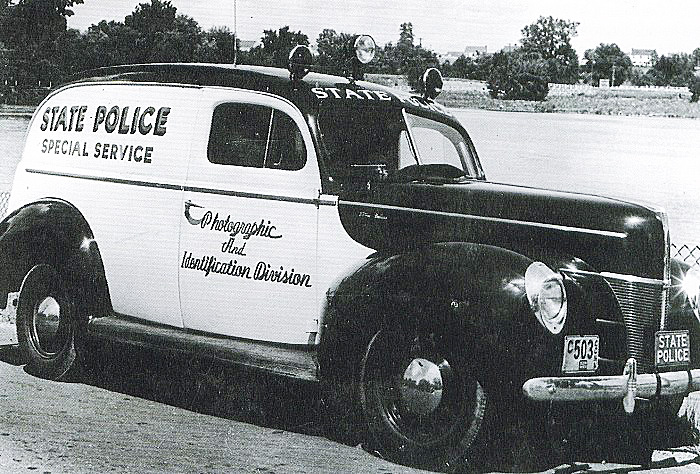
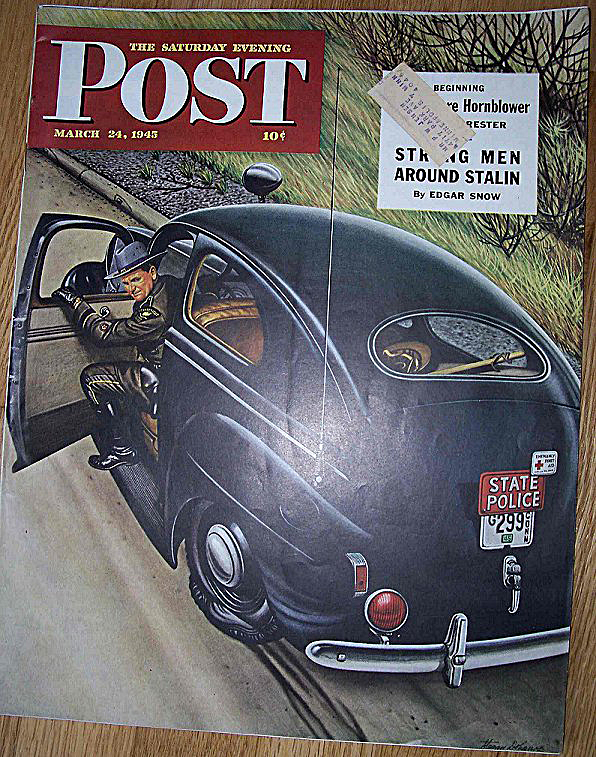 Cover of March 24 1943 issue of the Saturday Evening Post Magazine
Cover of March 24 1943 issue of the Saturday Evening Post Magazine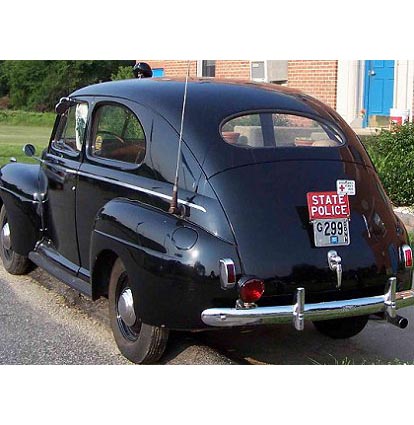 Restored 1941 CSP Ford Patrol Car. A match to every last detail from the CSP car of the 1943 Saturday Evening Post cover-right down to the same license number!
Restored 1941 CSP Ford Patrol Car. A match to every last detail from the CSP car of the 1943 Saturday Evening Post cover-right down to the same license number! 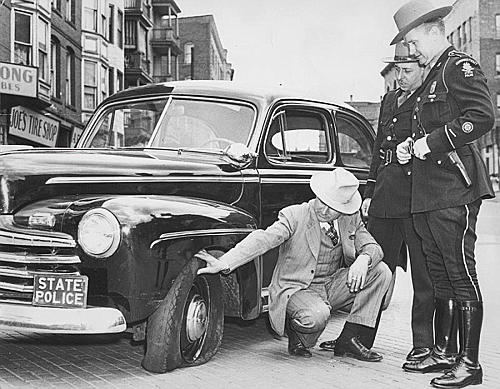
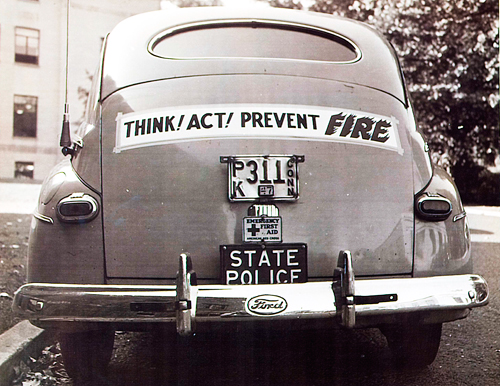
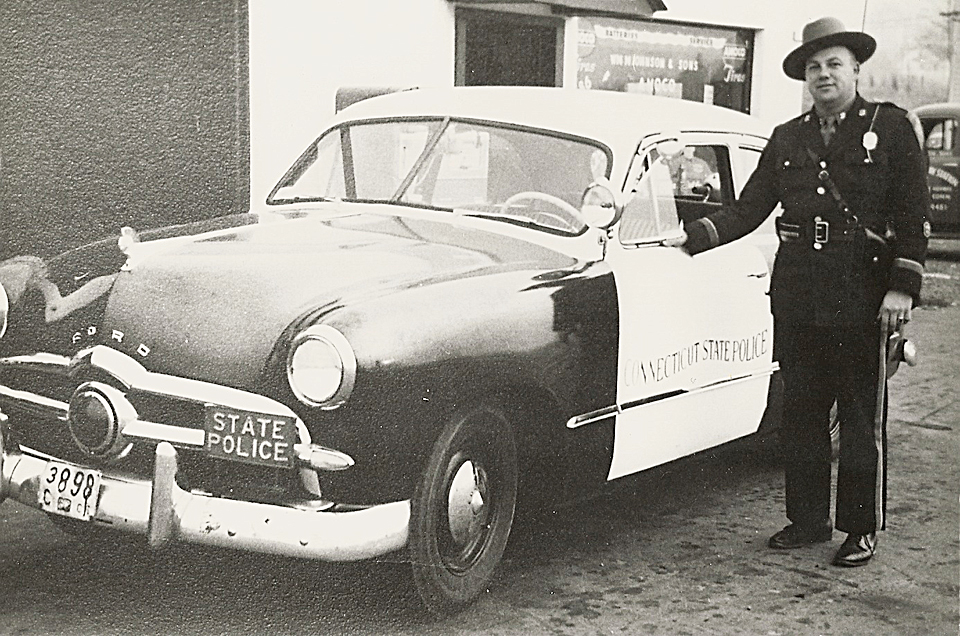
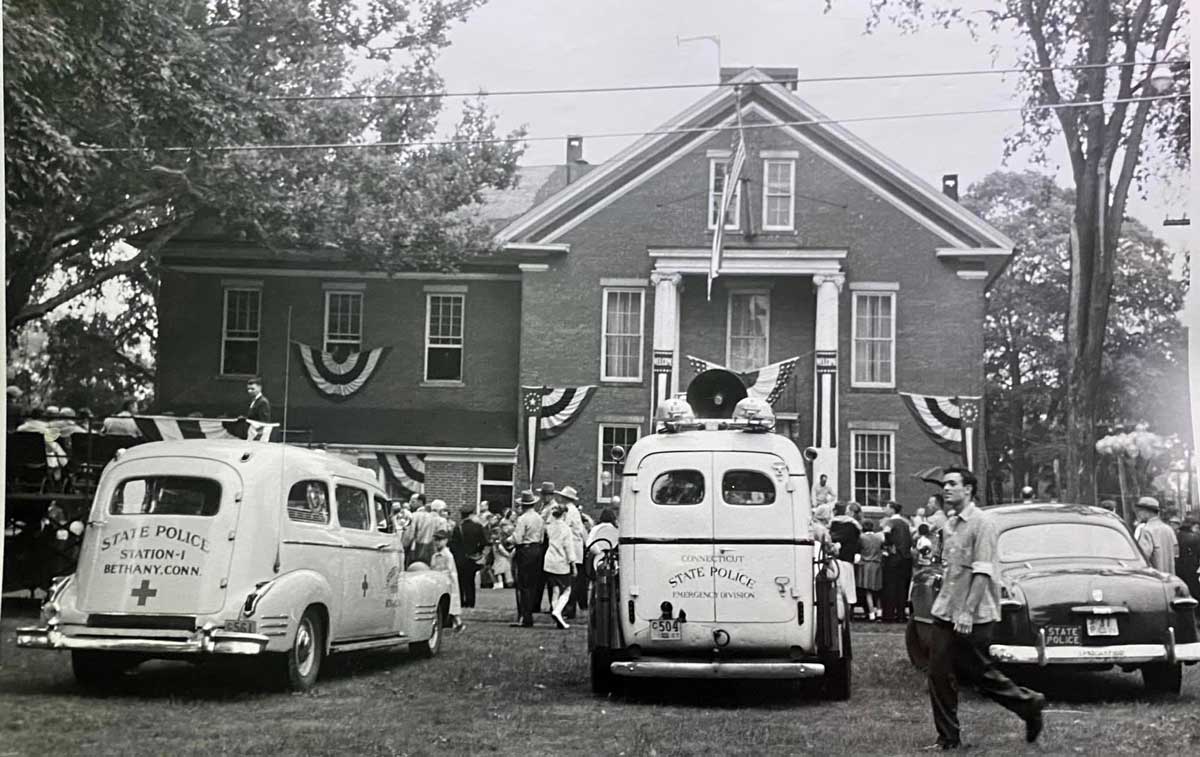 Late 1940's
Late 1940's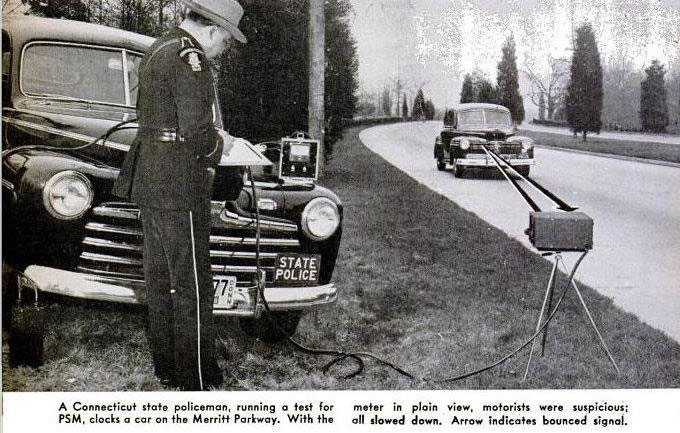 (Photo courtesy Tom Sheehy)
(Photo courtesy Tom Sheehy) In 1954, the Connecticut State Police unveiled a new replacement for the aging title plates they had been using for almost twenty years. It was a flat aluminum plate that was silkscreened in reflective material to heighten visibility in low-light conditions. This new material was heralded as a significant aid for officer safety. The new plates were still mounted using the same brackets and posts as their predecessors.
 Change-Over to reflective plates-
Change-Over to reflective plates-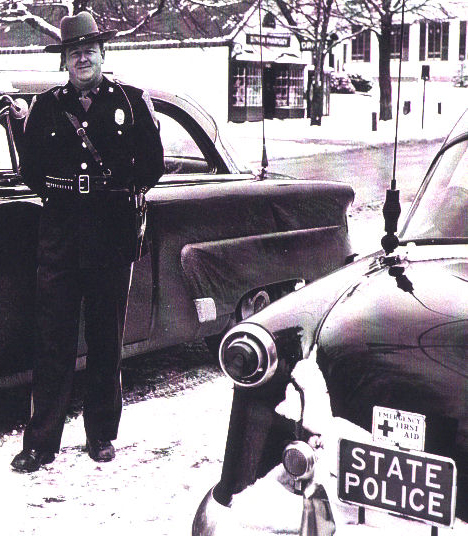 1954 Reflective issue
1954 Reflective issue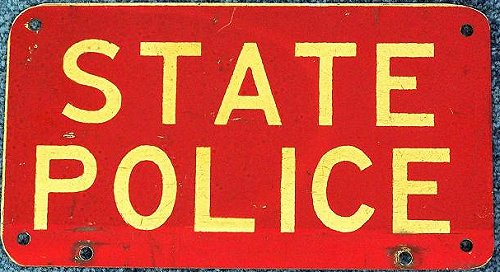 1954-1966 issue- Flat aluminum. Approx. 6" x 10 1/2".
1954-1966 issue- Flat aluminum. Approx. 6" x 10 1/2".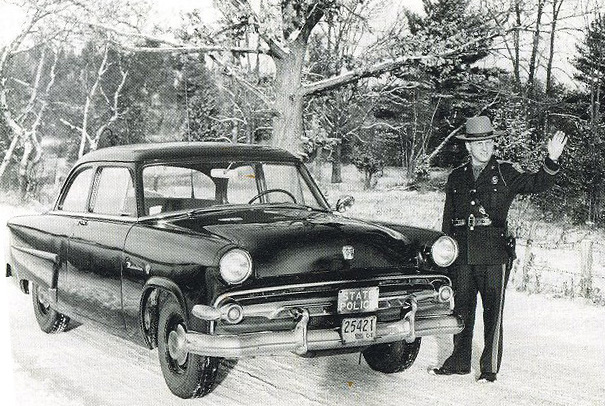 1954 Ford
1954 Ford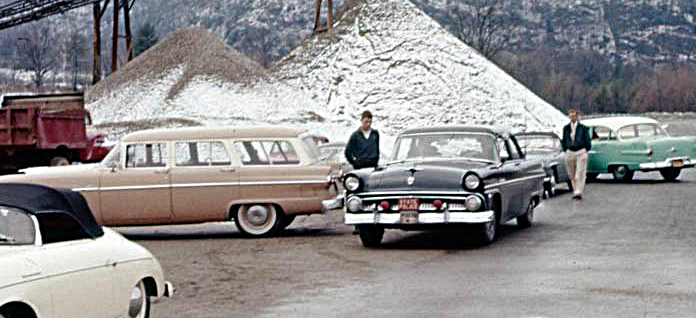
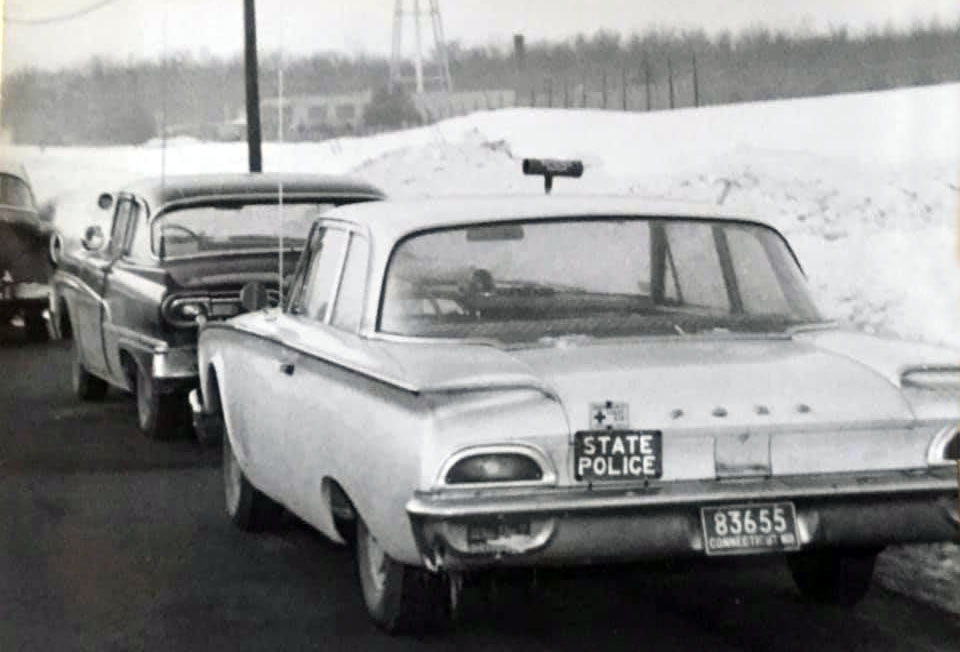 Circa 1960
Circa 1960
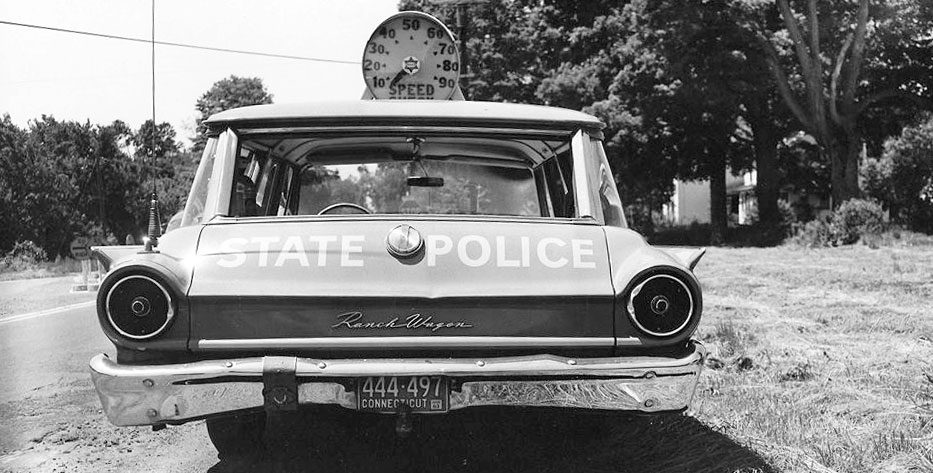 Connecticut State Police "Blue Goose" Ranch Wagon. Passenger car license plate with June 1963 validation decal.
Connecticut State Police "Blue Goose" Ranch Wagon. Passenger car license plate with June 1963 validation decal. 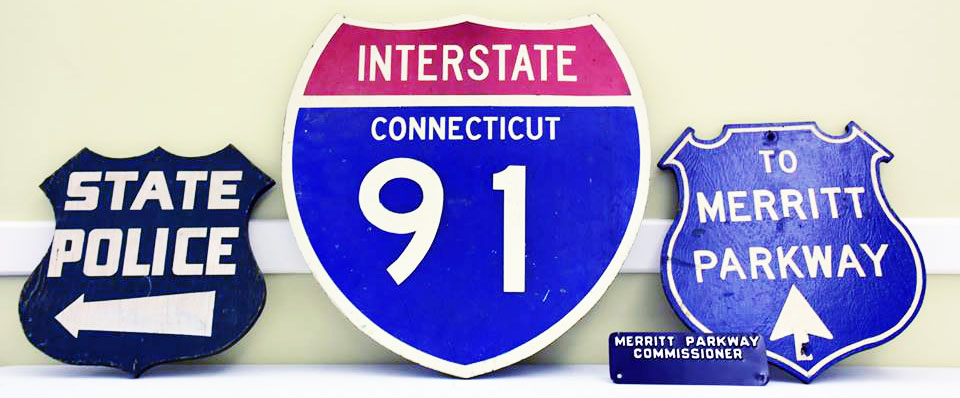
In 1964, Connecticut State Police began using title plates that were cut into the shape of the state shield. These plates have come to be known as "cloverleaf" plates or signs in collecting circles. The smaller rectangular reflective white over red title plates introduced ten years earlier were being phased-out. The larger cloverleaf shields measured approximately 11 3/4" by 10 1/2" and were mounted on the front and rear of CSP patrol vehicles. Some of these plates were mounted by means of steel posts attached to a backing bracket and dropped through two pre-drilled holes in the vehicle's bumper as with previous issues. Others were simply mounted directly through the front grille or trunk deck on the rear. It is believed that the yellow-gold over blue cloverleaf shield was the first color scheme used before the reflective white over red shields. Some of these cloverleaf shields have BOTH color schemes on the flip-side of each other so that either could be used.
Some of these shields may look the same, but there were two distinct font styles used. The earlier one used a thicker and tighter font, and the later version featured a thinner font which has the letters spaced further apart.
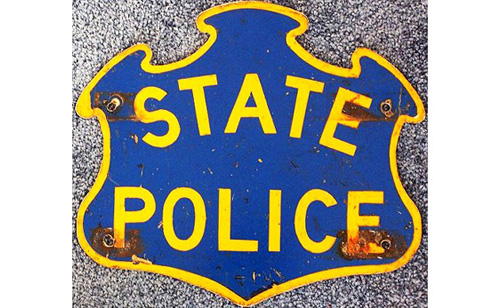 Circa 1964 to 1970's issue-
Circa 1964 to 1970's issue-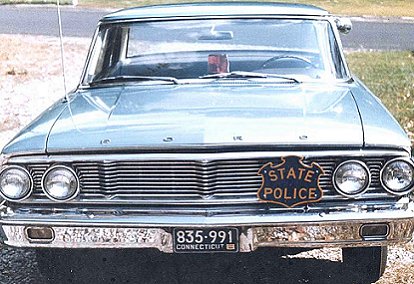 1964 CSP Ford
1964 CSP Ford 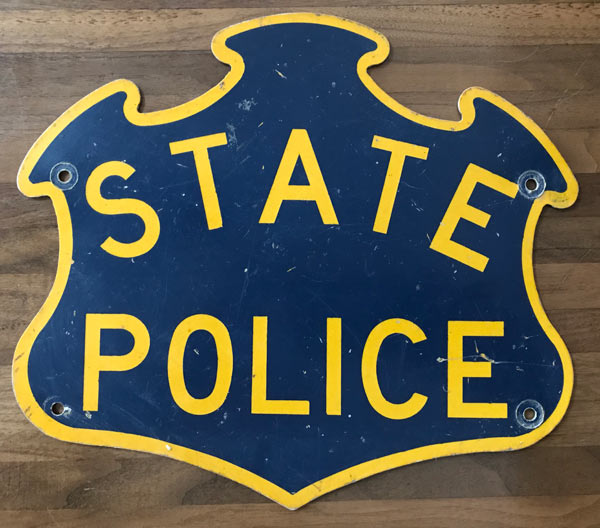 Circa 1964-1970's issue-
Circa 1964-1970's issue- 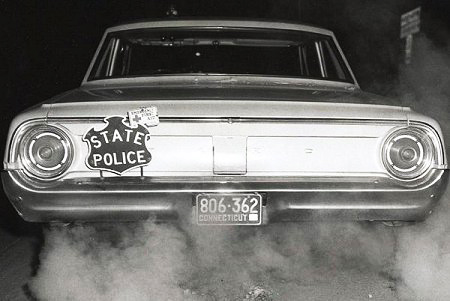 1964 CSP Ford
1964 CSP Ford 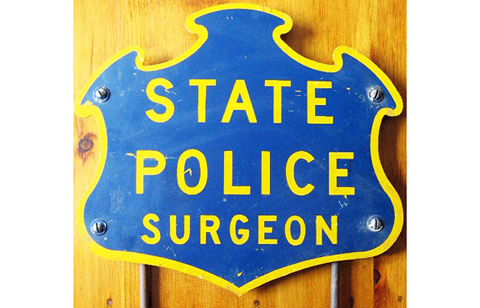 Circa 1964-1970's issue-
Circa 1964-1970's issue-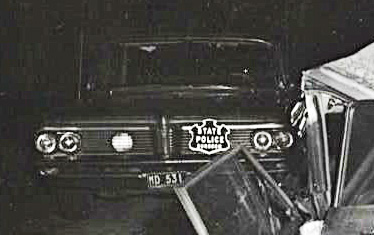 Doctor John Kilgus' CSP Pontiac at scene of fatal MVA - 1965
Doctor John Kilgus' CSP Pontiac at scene of fatal MVA - 1965 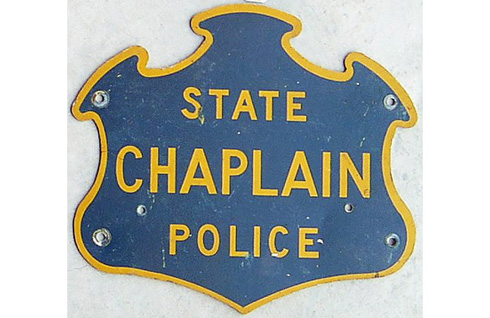 Circa 1964-1970's issue-
Circa 1964-1970's issue- 
 Circa 1964-1970's SPECIAL issue-
Circa 1964-1970's SPECIAL issue- 
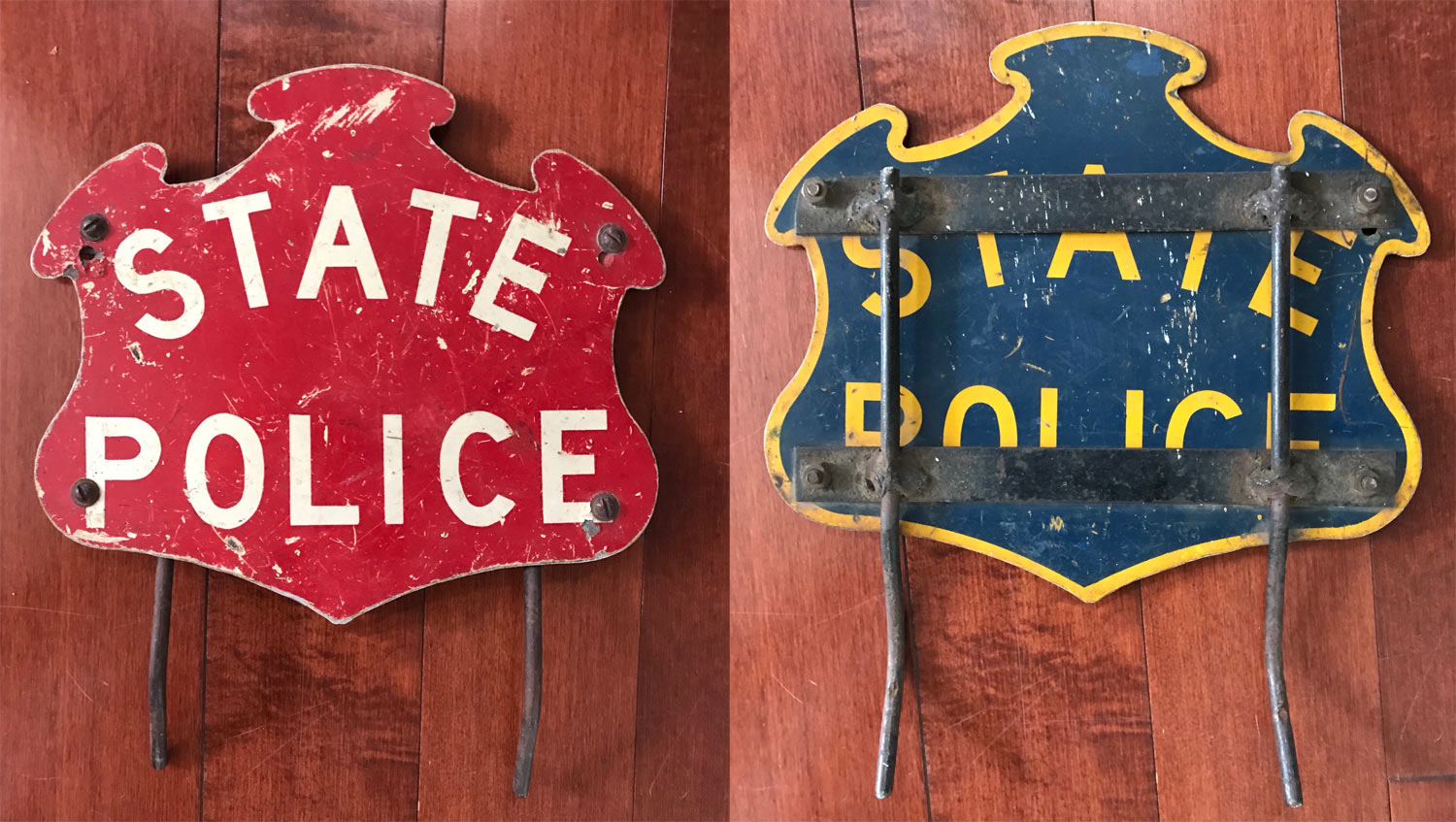 Further proof that the red shield plates were issued AFTER the blue and gold shields, as this borderless red shield was made on the flip-side of the older blue shield. There is still no clear time frame as to which version came out when, but we now know that the blue shields did come out before any of the red ones. Both shields continued in use sporadically into the 1980's.
Further proof that the red shield plates were issued AFTER the blue and gold shields, as this borderless red shield was made on the flip-side of the older blue shield. There is still no clear time frame as to which version came out when, but we now know that the blue shields did come out before any of the red ones. Both shields continued in use sporadically into the 1980's.  Circa 1964-1970's issue-
Circa 1964-1970's issue- 
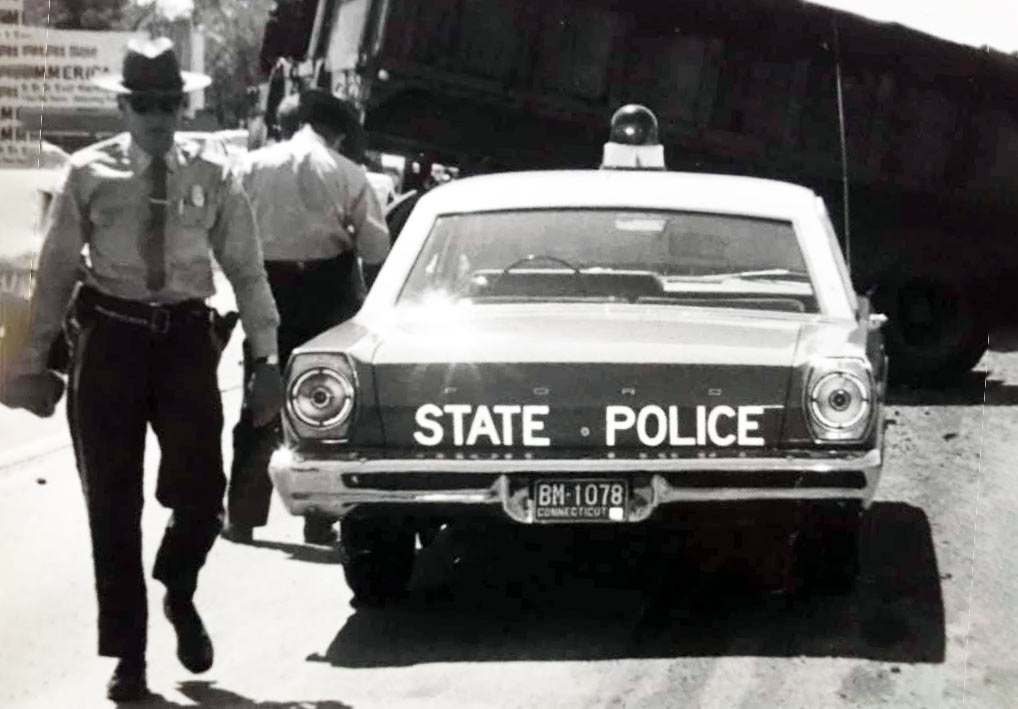 Circa 1965
Circa 1965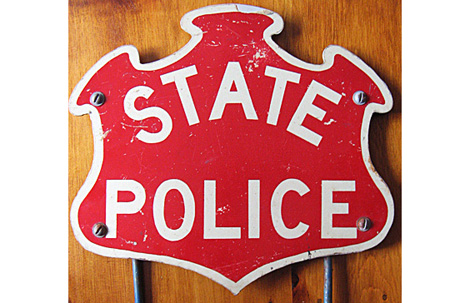 Circa 1964-1970's issue-
Circa 1964-1970's issue- 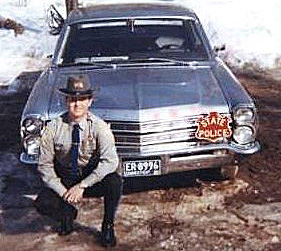
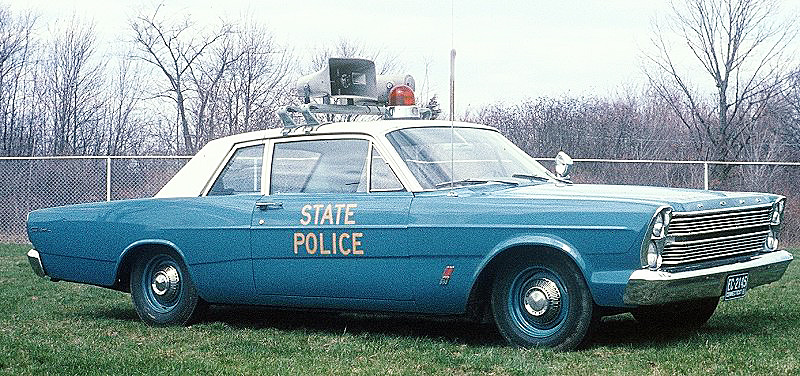
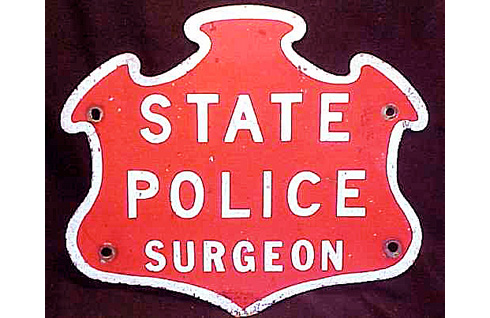 Circa 1964-1970's issue-
Circa 1964-1970's issue- 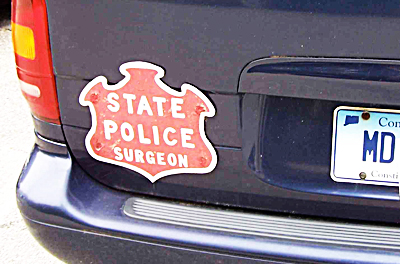 CTSP Surgeon Shield in Current Use with Ct "MD" license plate.
CTSP Surgeon Shield in Current Use with Ct "MD" license plate. 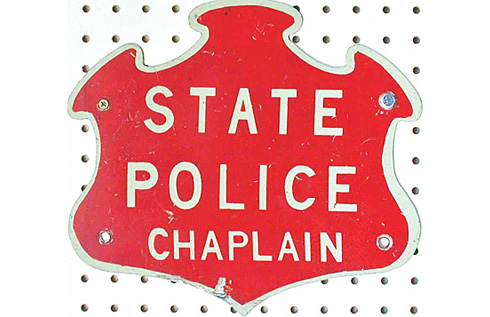 Circa 1964-1970's issue-
Circa 1964-1970's issue- 
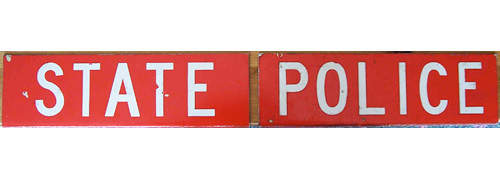 Circa 1969-early 1980's light bar signs. Reflective white over red. (Approx 4" x 14" each)
These aluminum signs were affixed to the rooftop light bar on either side of
the rotator light . The signs were also marked on the backside so
that STATE POLICE could be read from the front and the
rear of the car.
Click here to read an entertaining historical anecdote on the early roof racks used by the CSP
Circa 1969-early 1980's light bar signs. Reflective white over red. (Approx 4" x 14" each)
These aluminum signs were affixed to the rooftop light bar on either side of
the rotator light . The signs were also marked on the backside so
that STATE POLICE could be read from the front and the
rear of the car.
Click here to read an entertaining historical anecdote on the early roof racks used by the CSP
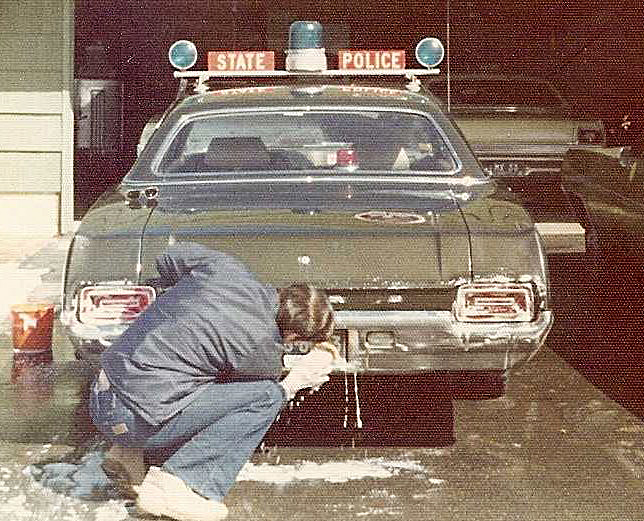
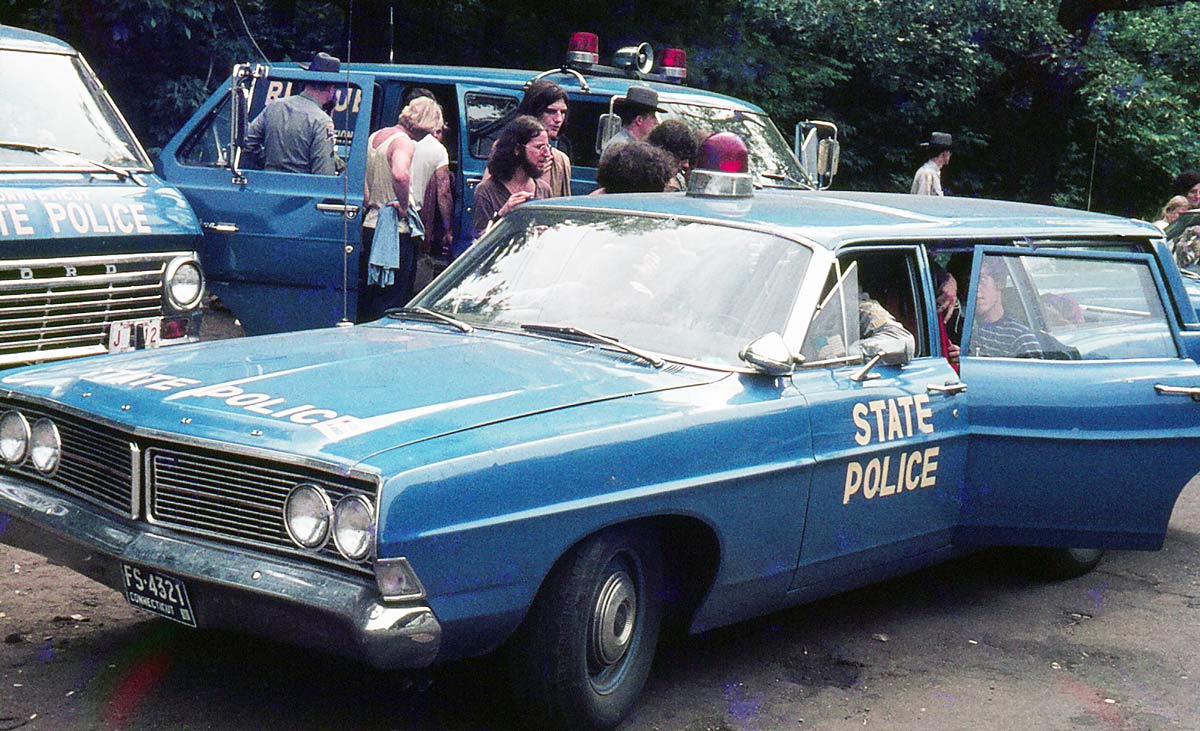 1971
1971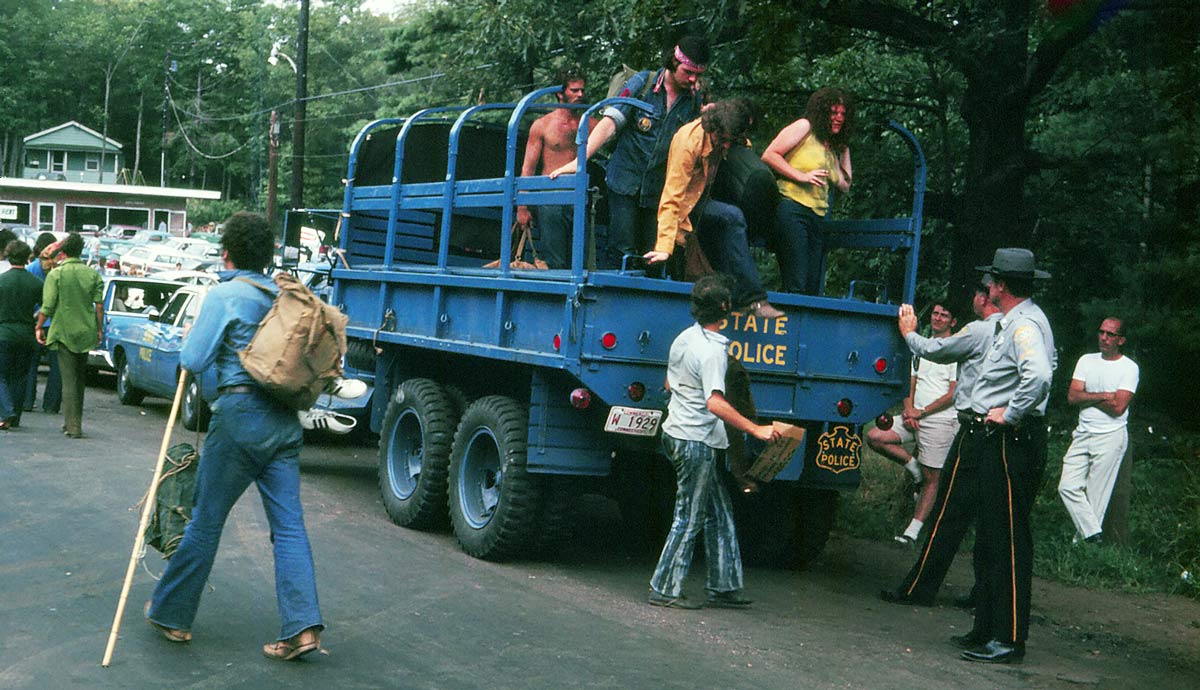 1971
1971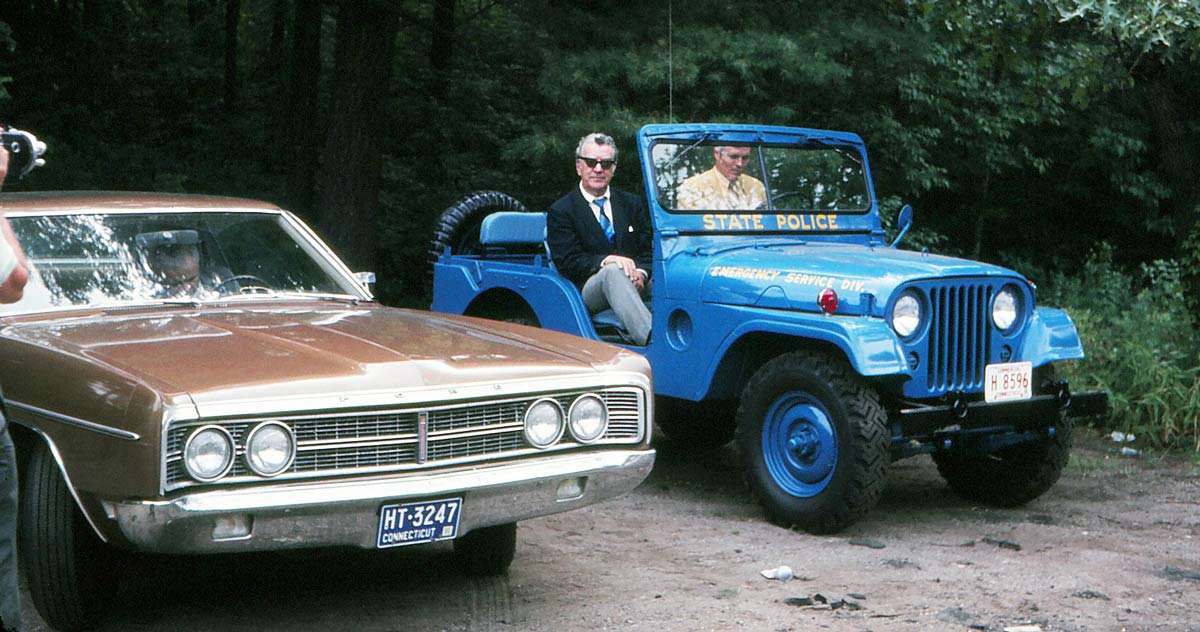 1971
1971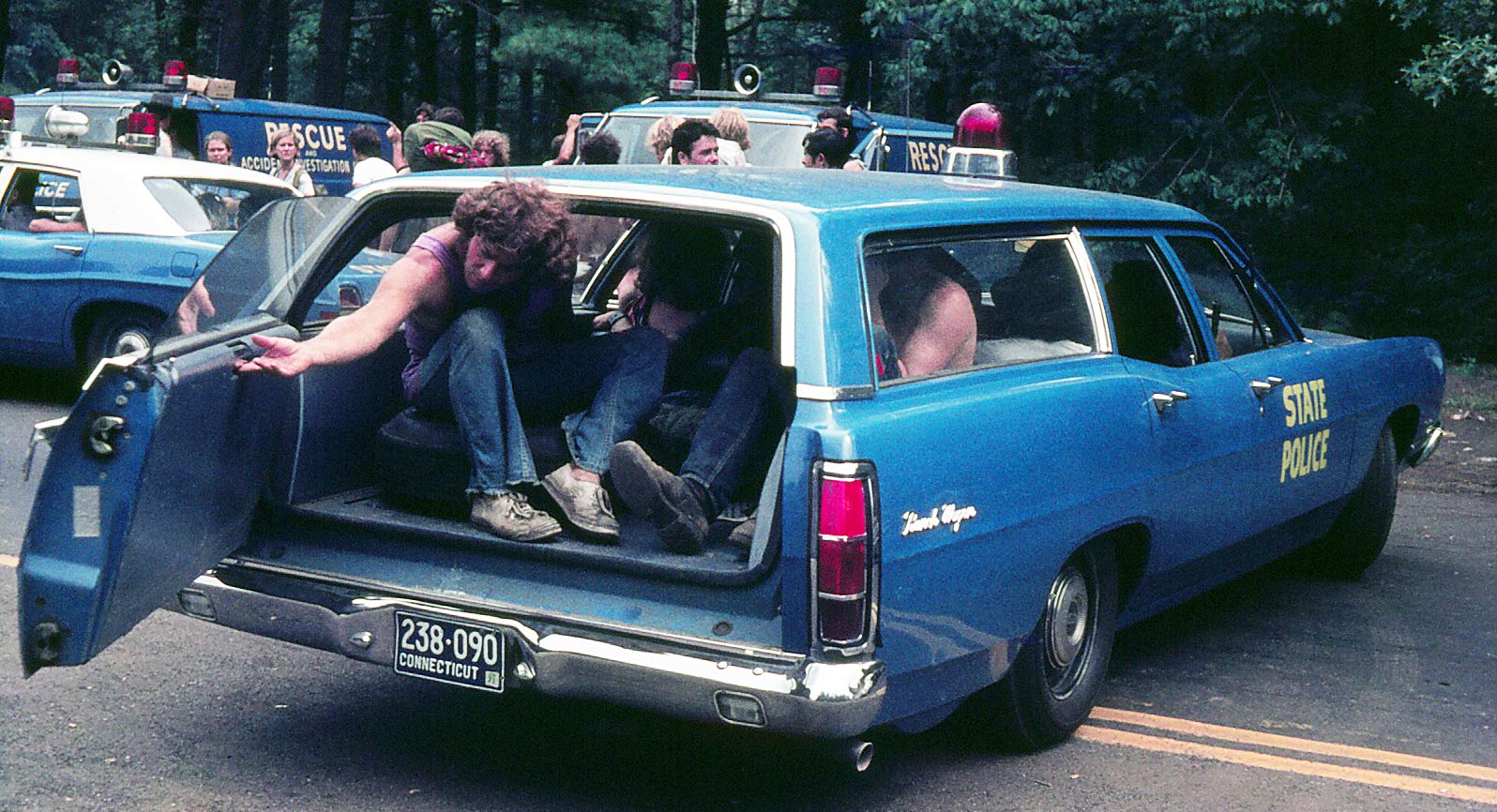 1971
1971 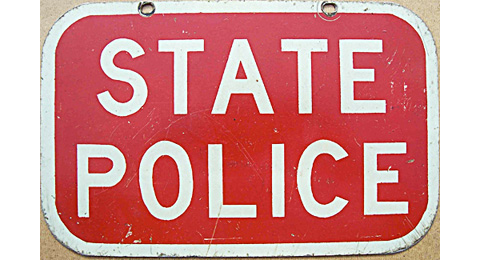 Circa 1972-early 1990's issue. Flat heavy gauge aluminum. Approx 7" X 11". Reflective white over reflective red. Mounting hole placement varies depending on vehicle.
Circa 1972-early 1990's issue. Flat heavy gauge aluminum. Approx 7" X 11". Reflective white over reflective red. Mounting hole placement varies depending on vehicle. 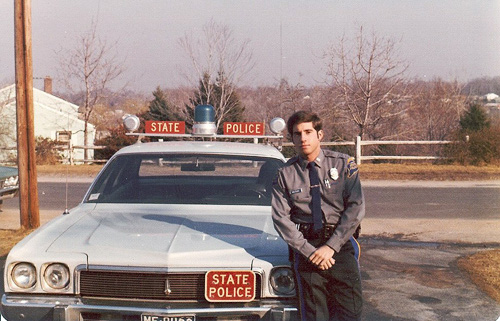 A young Trooper Ted Wojtusik with his 1973 Plymouth
A young Trooper Ted Wojtusik with his 1973 Plymouth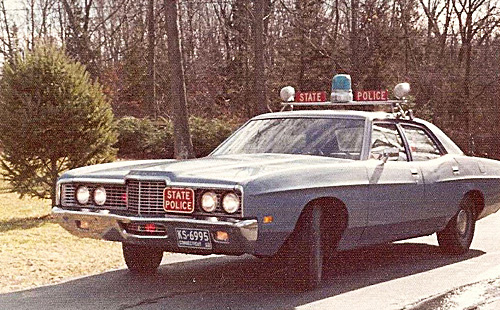 1972 Ford
1972 Ford 

 Circa 1972-1975 rear only issue.
Circa 1972-1975 rear only issue. 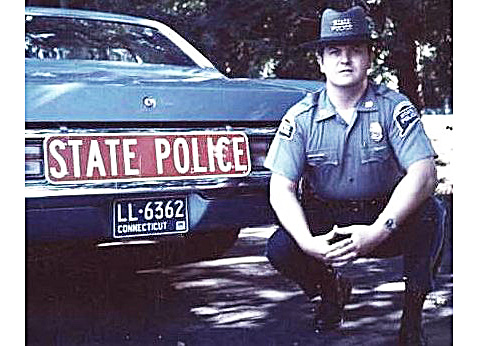
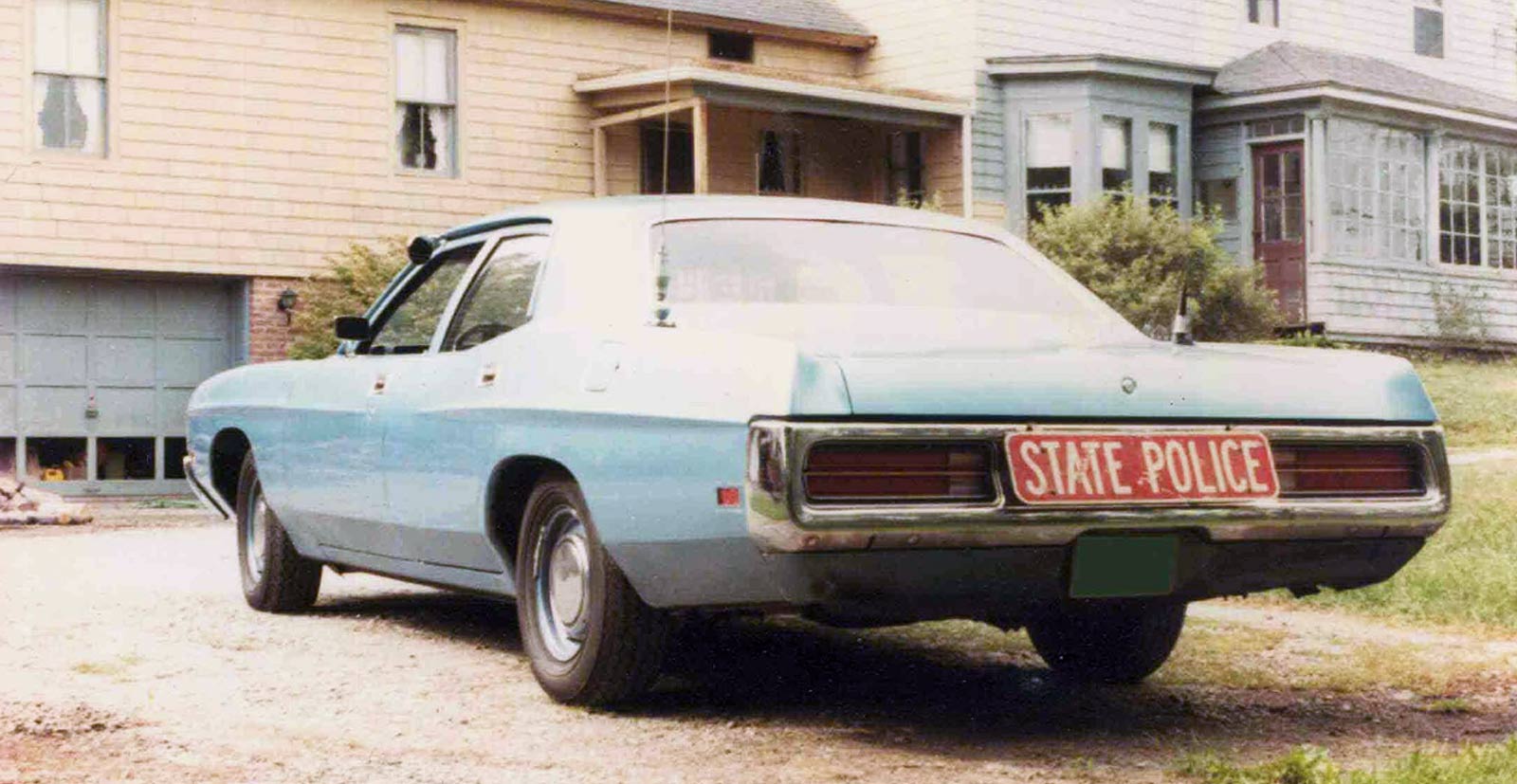
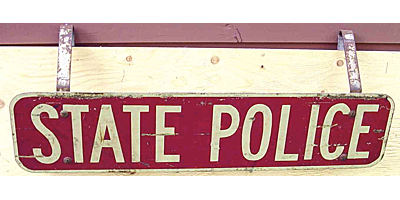 This photo shows the plate with mounting hooks still in place.
This photo shows the plate with mounting hooks still in place.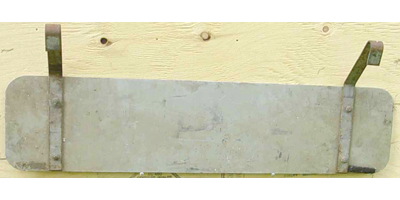 Same plate showing reverse side and mounting hook placement.
Same plate showing reverse side and mounting hook placement.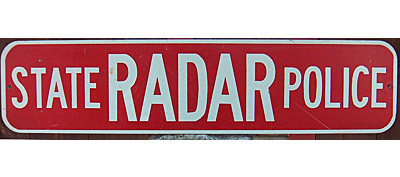 Circa 1972-1975 rear only issue.
Circa 1972-1975 rear only issue. 
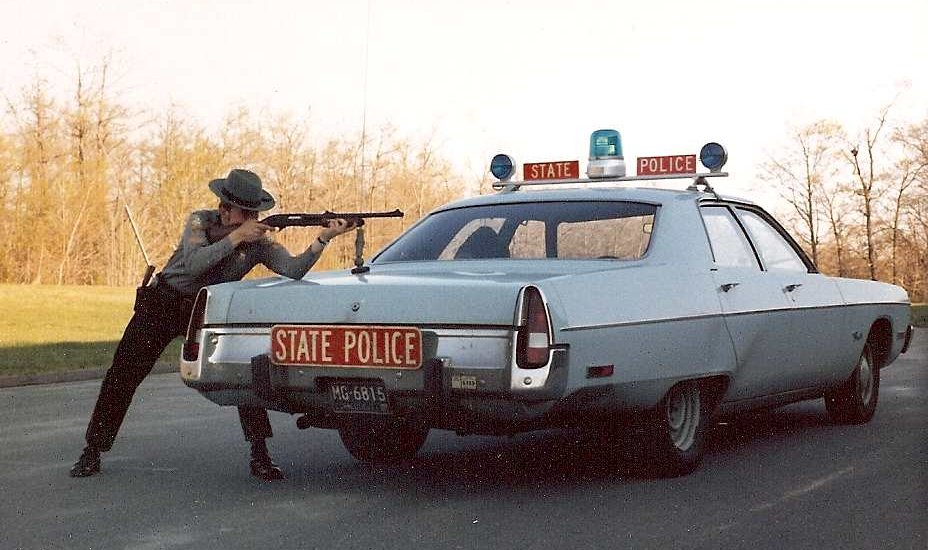
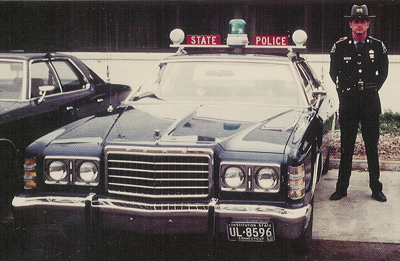 (Courtesy Glenn Pianka)
(Courtesy Glenn Pianka) (Courtesy Glenn Pianka)
(Courtesy Glenn Pianka)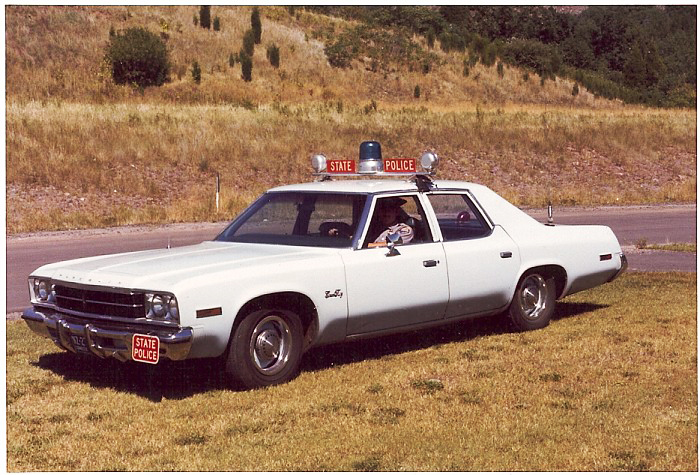
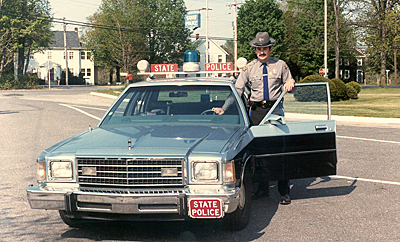 (Courtesy Ted Wojtusik)
(Courtesy Ted Wojtusik)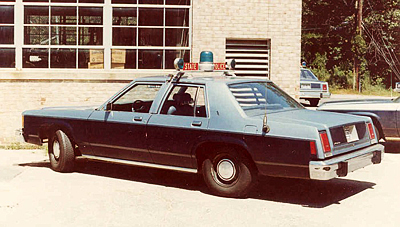 (Courtesy Ted Wojtusik)
(Courtesy Ted Wojtusik)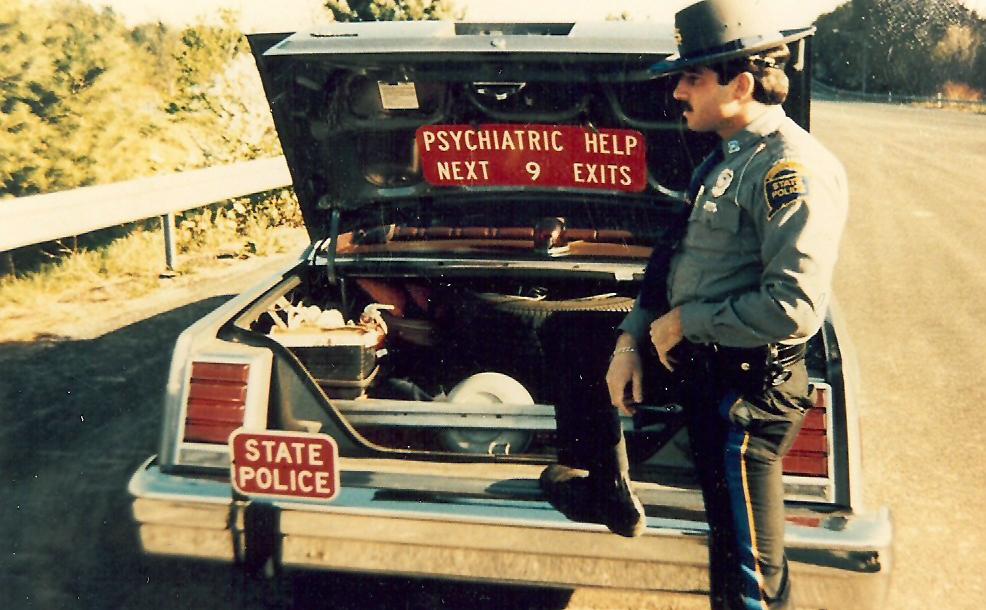
 Circa early 1980's light bar signs. Reflective yellow over blue. (Approx 4" x 14" each) These aluminum signs were affixed to the rooftop light bar on either side of the rotator light .
Circa early 1980's light bar signs. Reflective yellow over blue. (Approx 4" x 14" each) These aluminum signs were affixed to the rooftop light bar on either side of the rotator light . 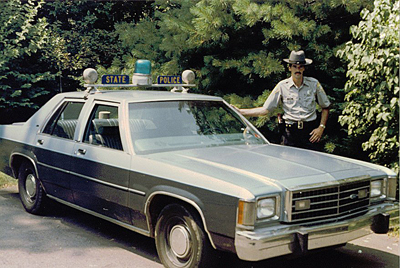 (Courtesy Ted Wojtusik)
(Courtesy Ted Wojtusik)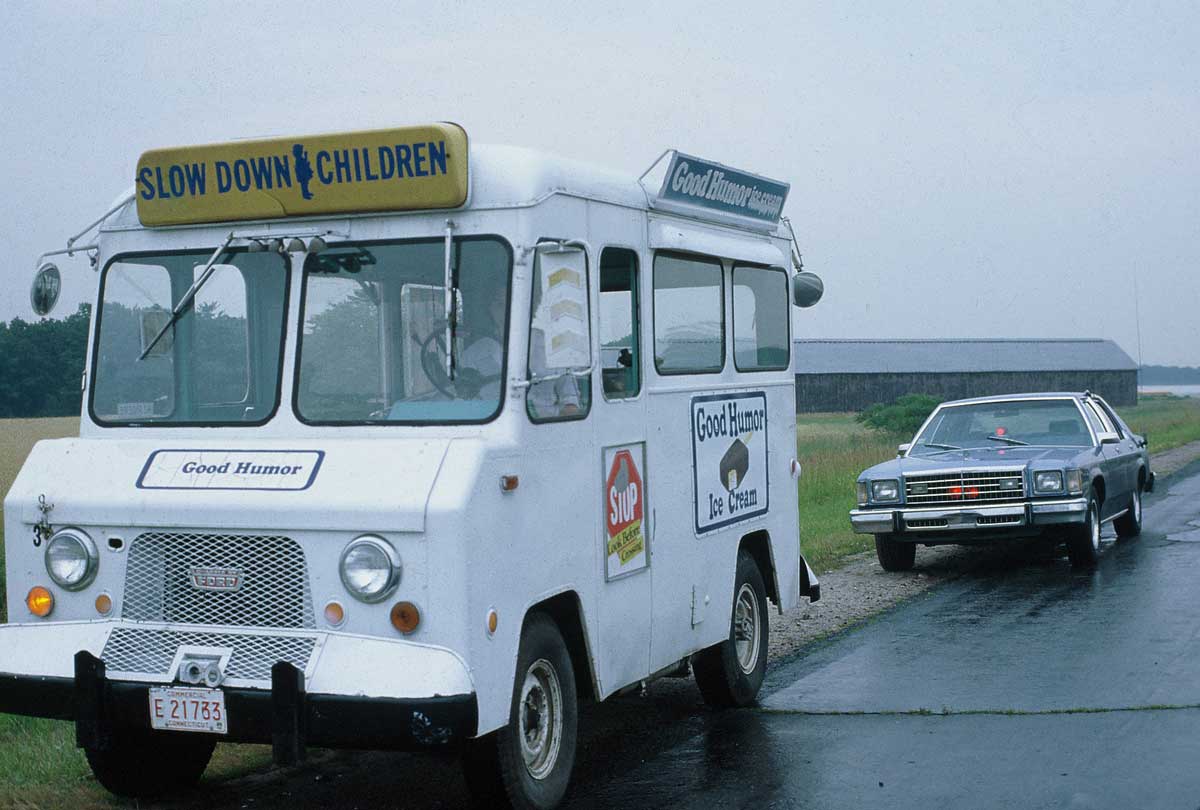 Traffic stop by Tpr. Ted Wojtusik on a hot muggy day in 1979- When he wanted ice cream
Traffic stop by Tpr. Ted Wojtusik on a hot muggy day in 1979- When he wanted ice cream 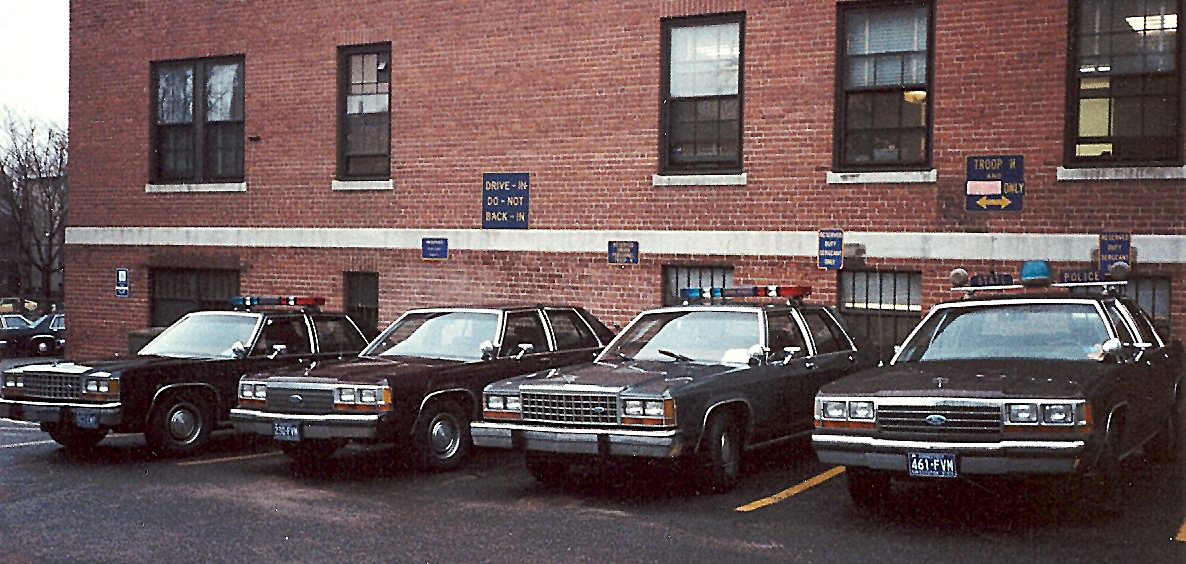
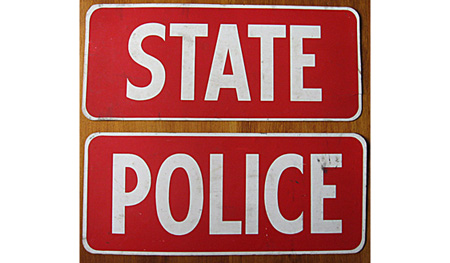 1985 Trunk Magnets- White over red vinyl (6" x 14") Experimental trial use for rear of CSP patrol cars.
1985 Trunk Magnets- White over red vinyl (6" x 14") Experimental trial use for rear of CSP patrol cars. 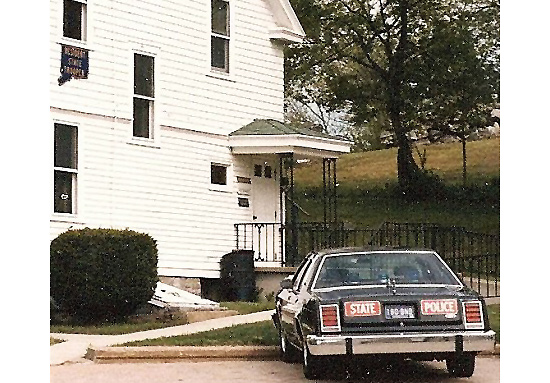 1985 Ford with magnet signage affixed.
1985 Ford with magnet signage affixed.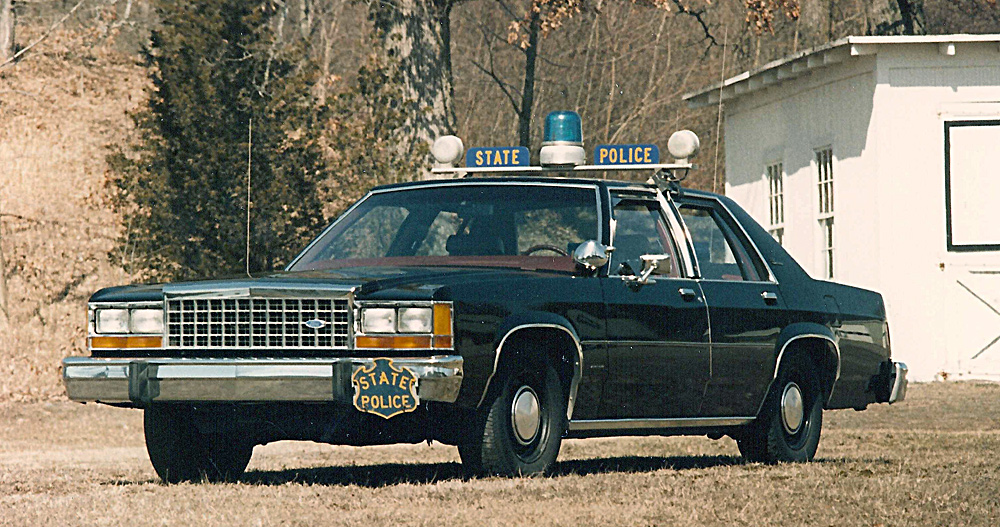
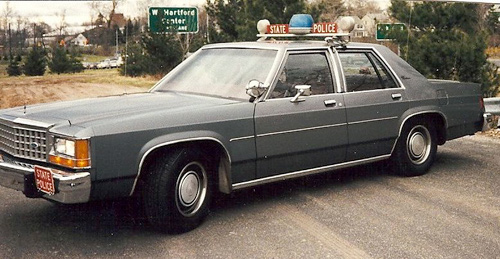 (Courtesy Ted Wojtusik)
(Courtesy Ted Wojtusik)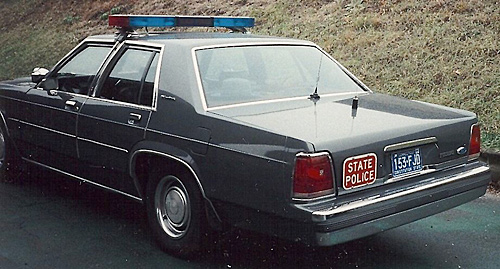 (Courtesy Ted Wojtusik)
(Courtesy Ted Wojtusik)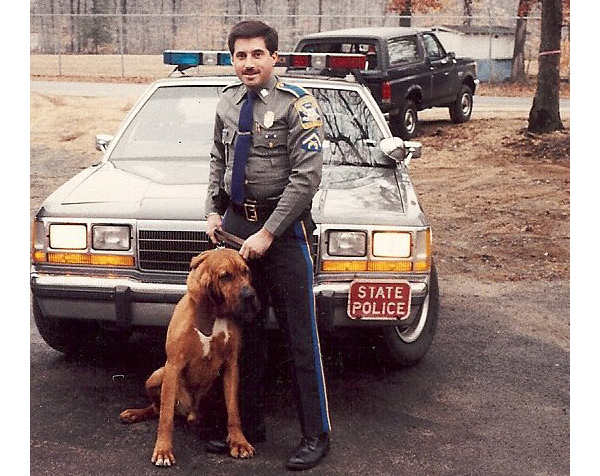
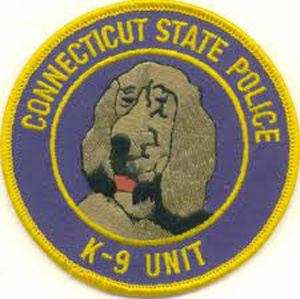
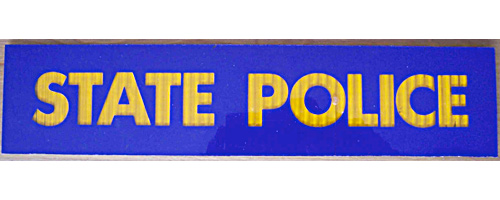 1990s Lightbar insert. Acrylic.
1990s Lightbar insert. Acrylic. 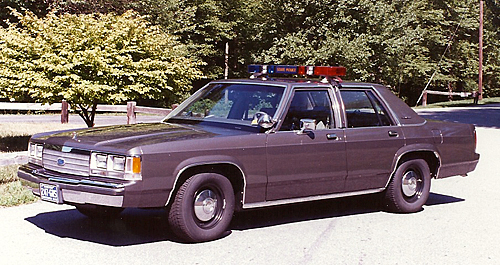
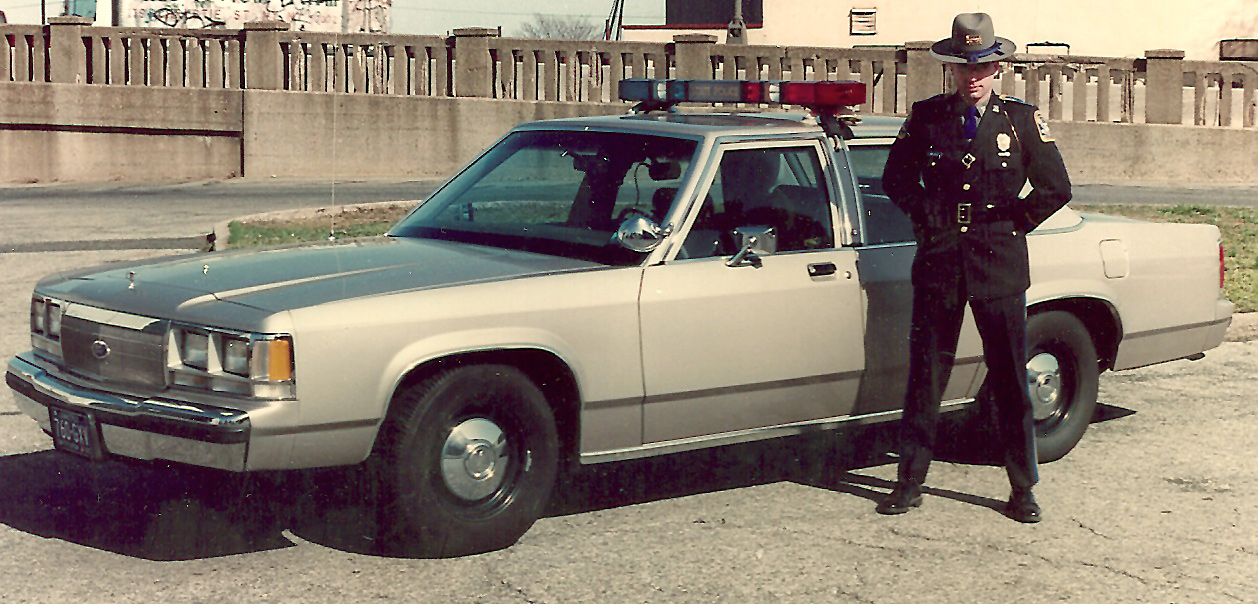
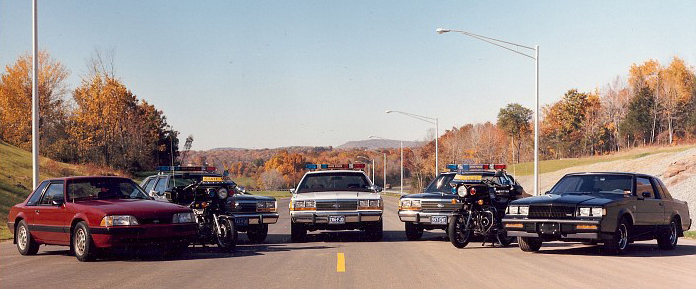
In 1990, Sgt Glenn Pianka was assigned out of Troop "D" in Danielson, and made contact with CCI after a joint project four years earlier between the company and the 200th Anniversary Committee for the town of Bozrah CT, of which Sgt Pianka was a member. CCI had helped to produce Bicentennial license plates for the event.
Sgt Pianka thought it would be a neat idea and a morale booster to have specially-made CSP license plates manufactured with badge numbers of CSP personnel on this attractive keepsake. There was a bit of reluctance on the part of CCI at first, but eventually the company agreed to produce these plates since they were going to be for state troopers after all.
These embossed aluminum plates were sold for $10 a pair, and Sgt Pianka received many orders from troopers and other ranking members of the CSP. Sales were restricted to CSP personnel only, and it was made clear from the outset that these plates were to be used solely as display items and not to be affixed to any vehicle, CSP or otherwise.
150 of these plates were sold, and a few "special" one-of-a-kind plates for Sgt Pianka were made (hey, why not?- It was HIS idea after all!) including a reverse-colored (blue over white) version with his trooper badge number 868, and another in the white over blue with CSP SGT featured below. Some like the # 860 plate featured no state silhouette.
Unfortunately, as with most police agencies, fun ideas get extinguished quickly and THIS fun had come to an abrupt end when CSP management decided to put a stop to the endeavor. Sgt Pianka was ordered not to obtain or distribute anymore of the "unauthorized" plates, however it is still not known who the author of the execution was. The decision to put an end to a promotional souvenir of pride by the very management of the same organization got many people upset, particularly those who were awaiting their orders to be completed.
Statetrooperplates.com thanks Retired Sgt Glenn Pianka for sharing this historical piece of information for the hobby and salutes his valiant attempt to "show the pride" of belonging to the Connecticut State Police with such a noble item.
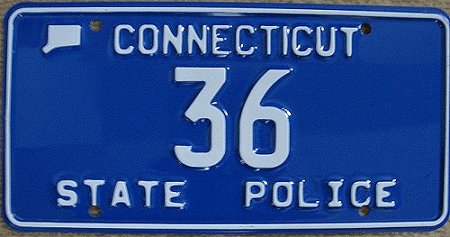
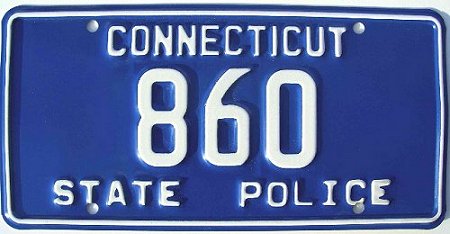
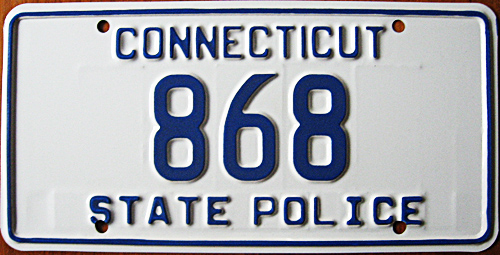
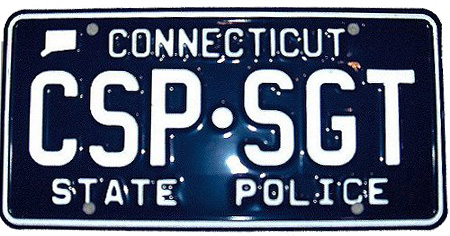
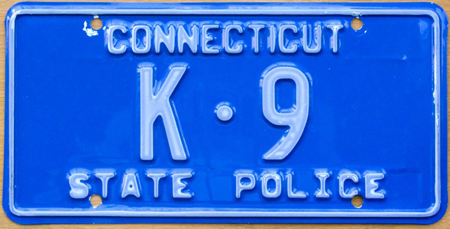 1980's issue- White over blue.
1980's issue- White over blue. 
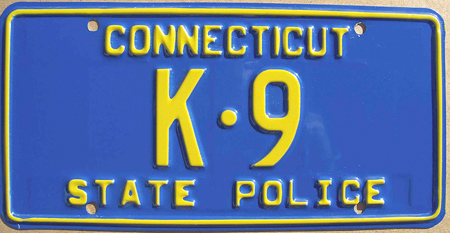 1980's issue- Yellow over blue.
1980's issue- Yellow over blue. 
 1980's issue- Blue over white.
1980's issue- Blue over white. 
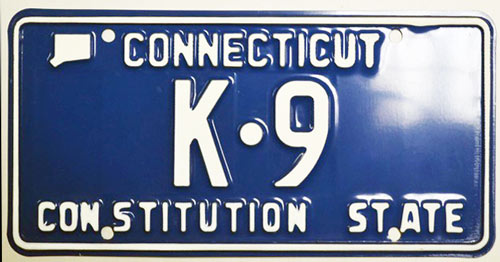 Late 1980's issue- White over blue.
Late 1980's issue- White over blue.
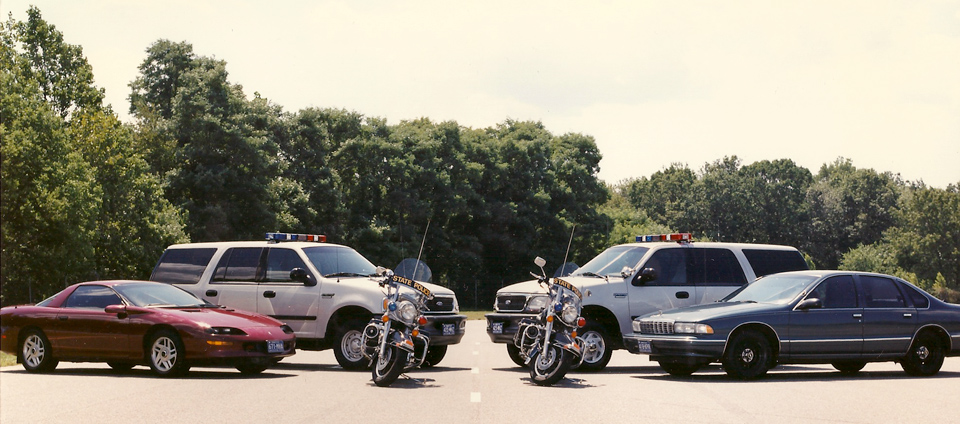
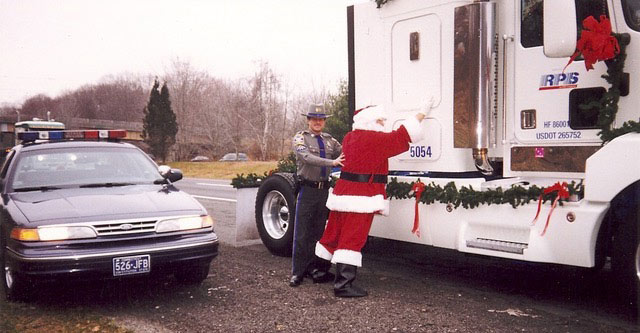 Santa's Log Book just doesn't add-up...
Santa's Log Book just doesn't add-up...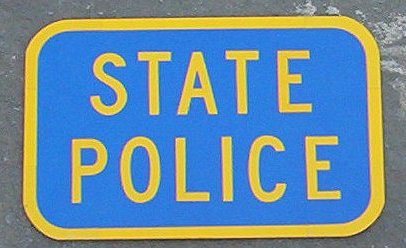 1980s/1990's. Yellow over blue.
1980s/1990's. Yellow over blue. 
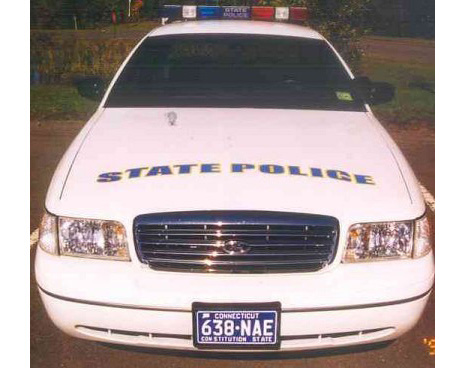
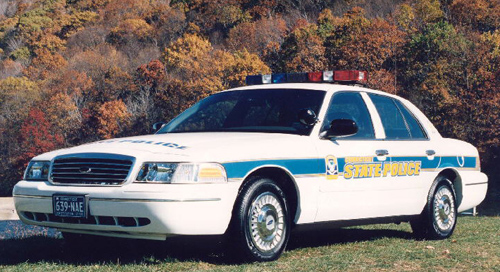 Marked CSP patrol car
Marked CSP patrol car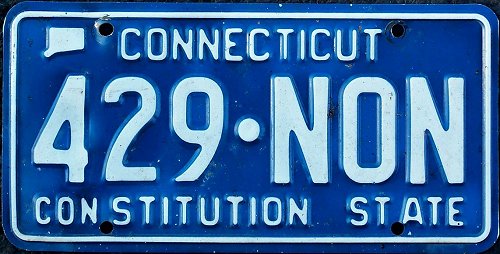 Actual registered CSP license plate used from July 28 1999 to July 28 2001.
Actual registered CSP license plate used from July 28 1999 to July 28 2001. 
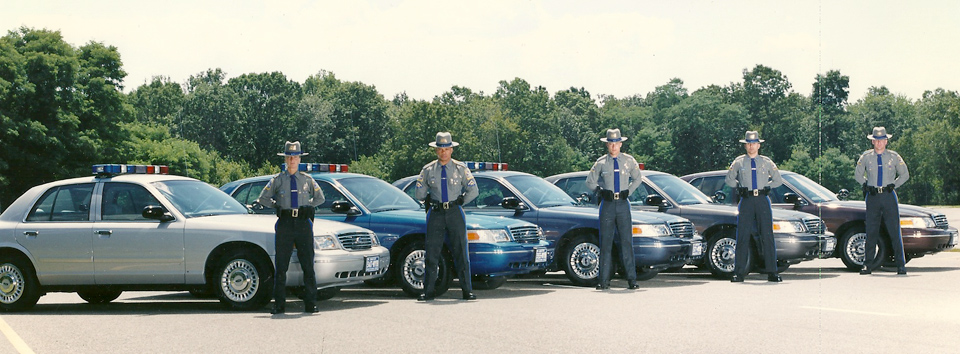
In 2001, the Connecticut State Police decided to reintroduce the cloverleaf title plate to be mounted on the rear decks of CSP patrol cars. The plastic and "cheap metal" shield measured roughly 9" by 10" and was nicknamed by some CSP Troopers as the "Turkey plate" due to its cut-out shape . The plate was still cut into the shape of the state shield, and had a reflective adhesive decal affixed to the shape with the word STATE over TROOPER. These plates also had enough space in the bottom center to permit a graphic depicting the rank of the member. There was also a distinct version for K-9 units as seen below. These title plates proved to be very unpopular with CSP troopers as they lacked durability and often interfered with the opening and closing of the patrol car's trunk including getting damaged during same.
This title plate gradually got phased out as more became damaged or gone missing.
During their period of usage, several could be found alongside Connecticut highways in varying degrees of just-plain-broken.
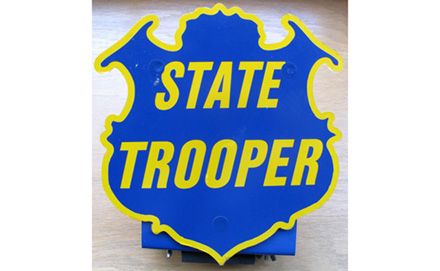 Circa 2001 issue. Plastic and metal rear deck shield.
Circa 2001 issue. Plastic and metal rear deck shield. 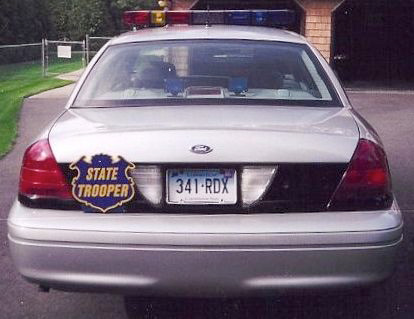
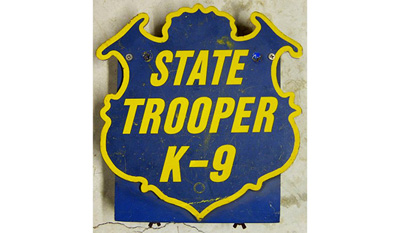 Circa 2001 K-9 issue. Plastic and metal rear deck shield. Approx. 9" x 10". Reflective yellow-gold over reflective blue.
Circa 2001 K-9 issue. Plastic and metal rear deck shield. Approx. 9" x 10". Reflective yellow-gold over reflective blue.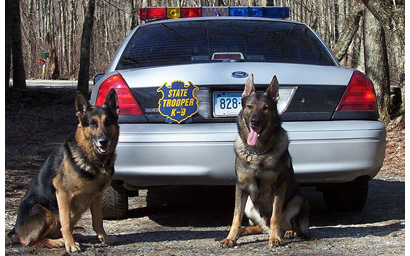 K9 Officers Joel and Max
K9 Officers Joel and Max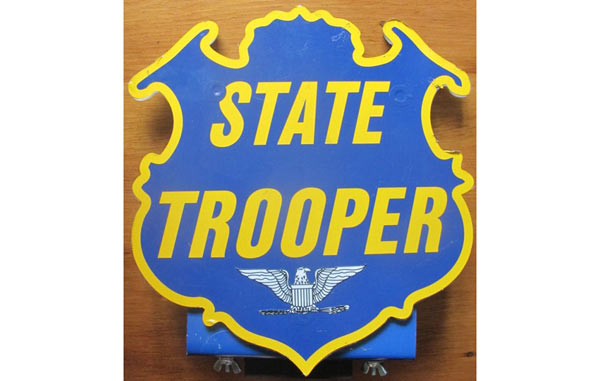 Circa 2001 issue.
Circa 2001 issue. 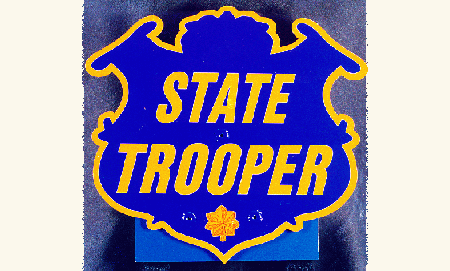 Circa 2001 issue.
Circa 2001 issue. 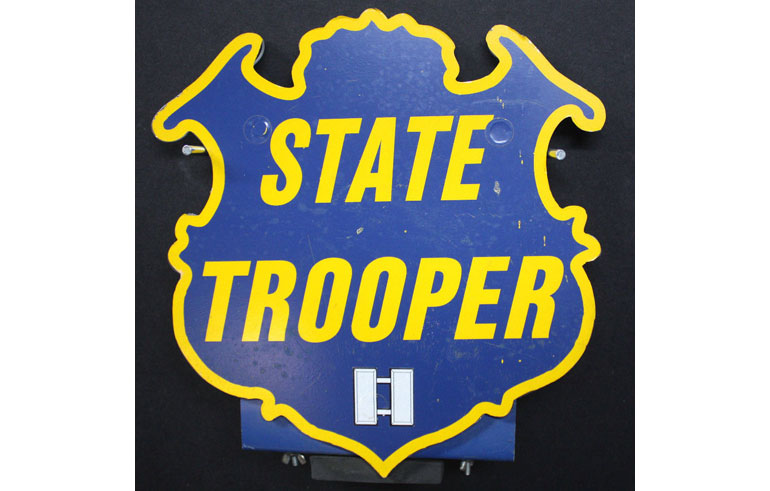 Circa 2001 issue.
Circa 2001 issue. 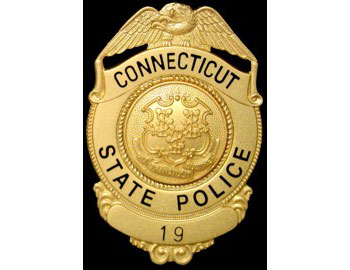
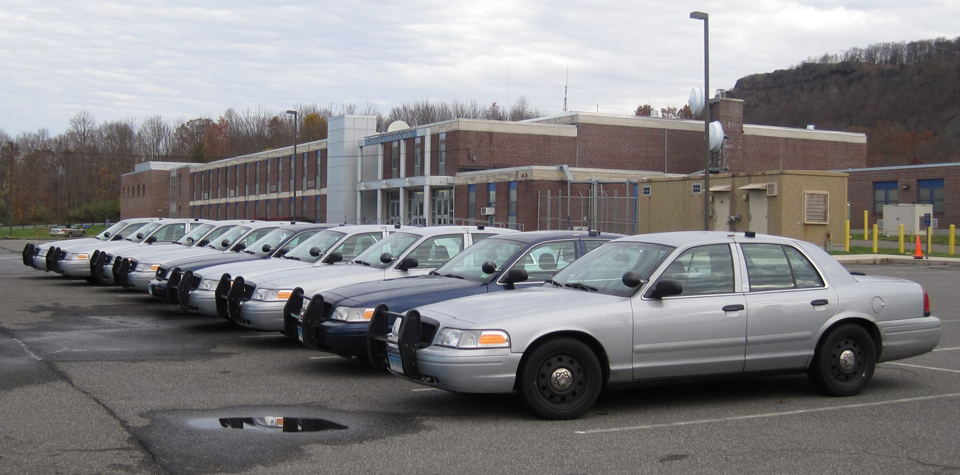
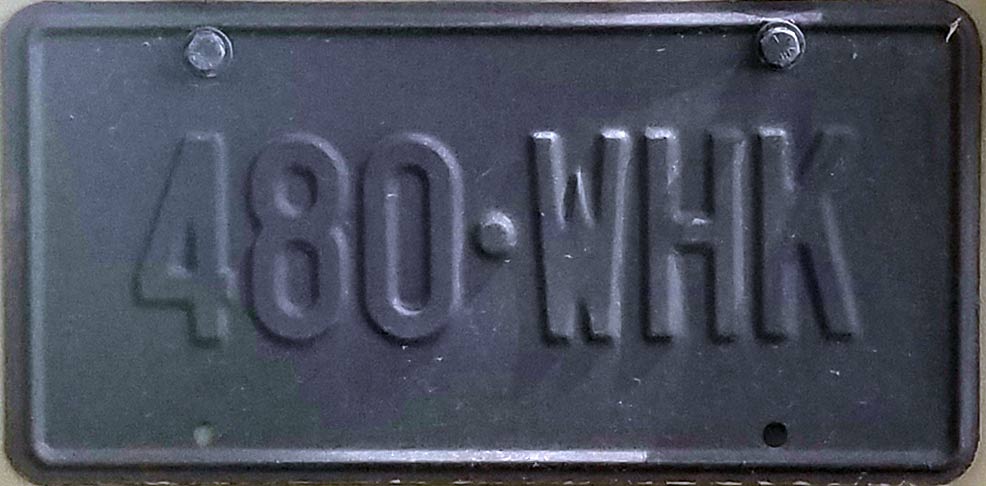 2016/2017 Tactical Unit issue.
2016/2017 Tactical Unit issue.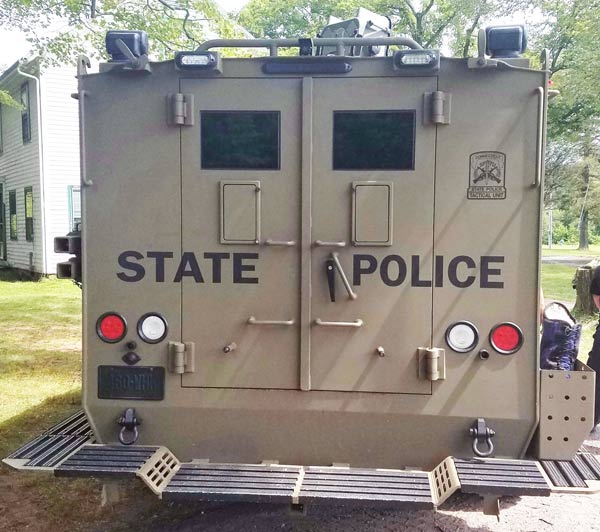
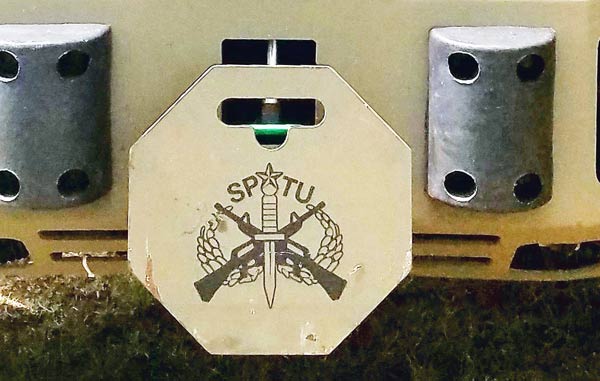 2016/2017 Tactical Unit.
2016/2017 Tactical Unit.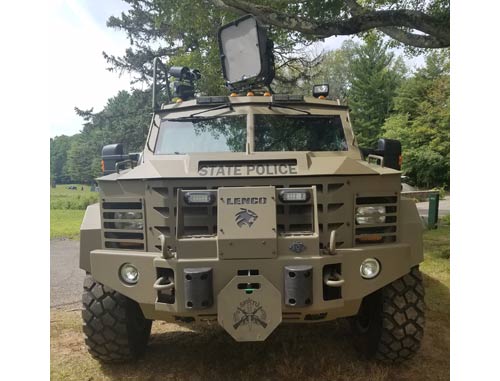
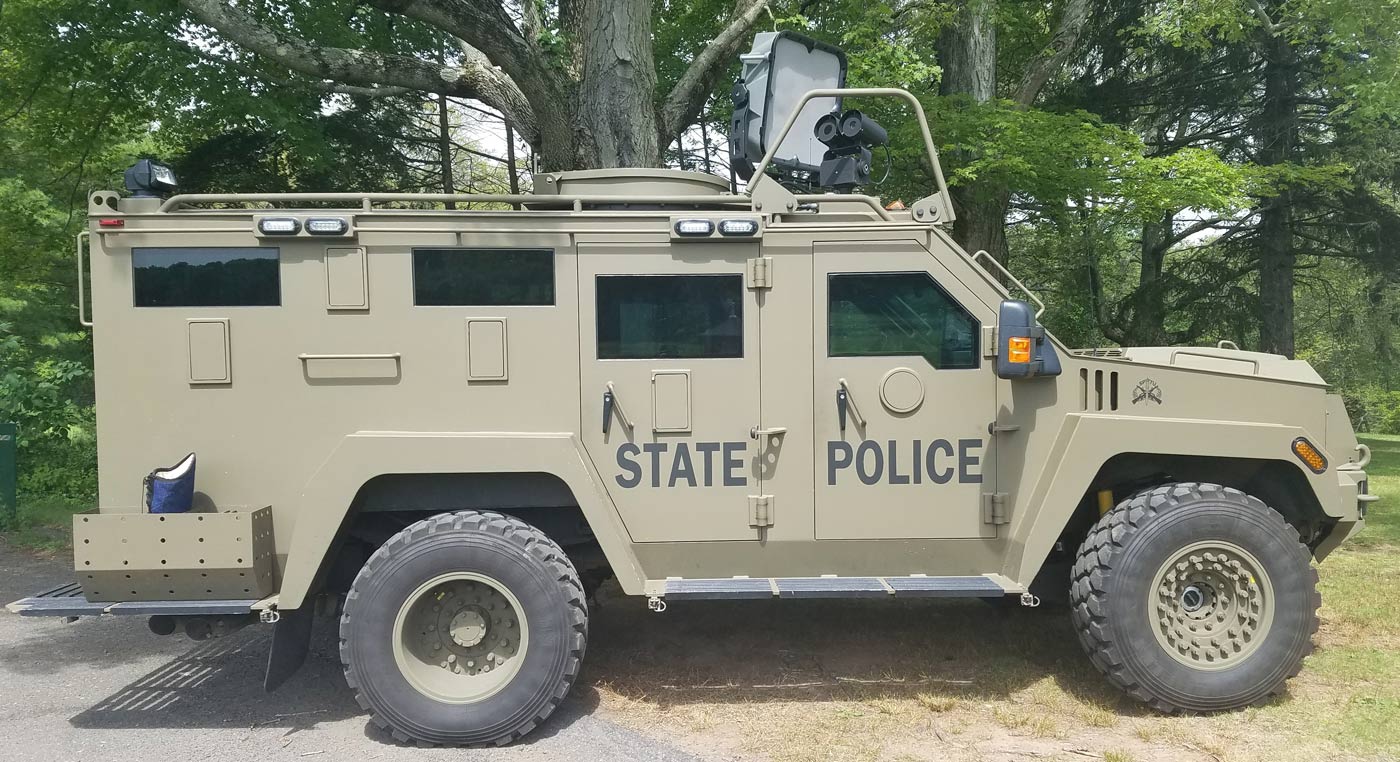
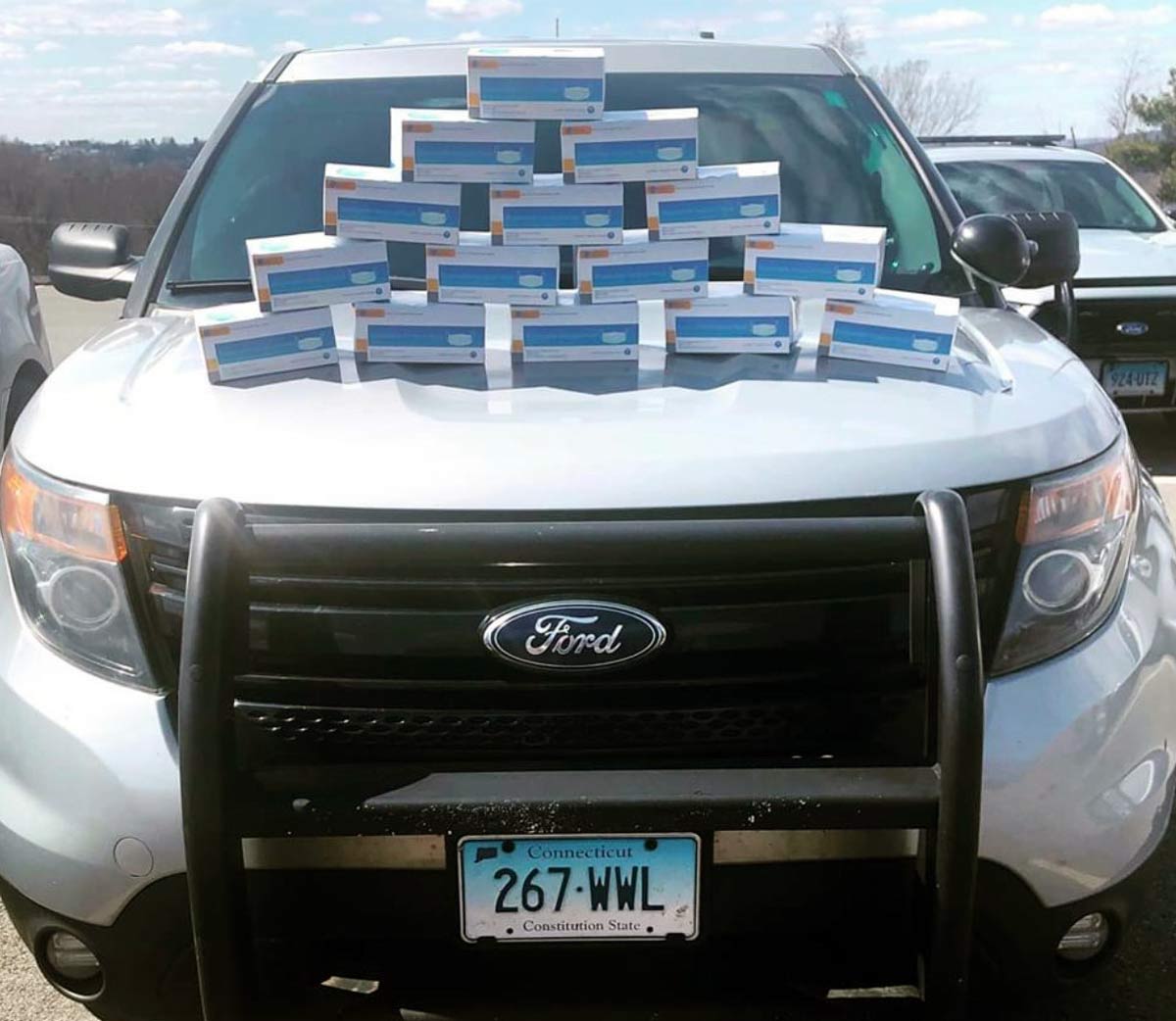 2020 issues. UTZ suffix in background and WWL suffix in foreground.
2020 issues. UTZ suffix in background and WWL suffix in foreground.These are CSP vehicle signs and plates for specialty usage.
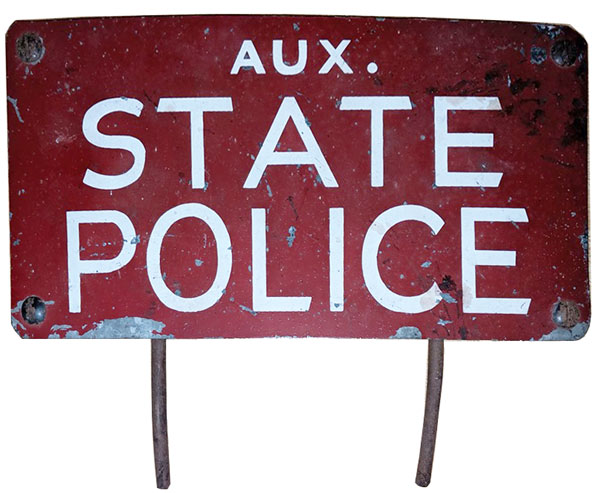 Circa 1960's Auxiliary State Police car sign.
Circa 1960's Auxiliary State Police car sign.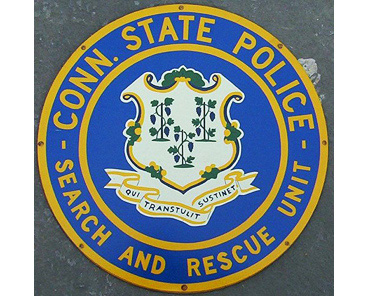 Identification sign from the side of Emergency Services Unit truck-
Identification sign from the side of Emergency Services Unit truck-  Identification sign from the side of Emergency Services Unit truck- Usage from 1950's into the 1970's.
Identification sign from the side of Emergency Services Unit truck- Usage from 1950's into the 1970's. 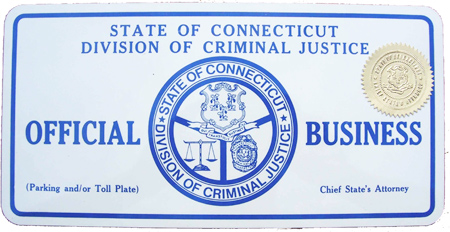 Although technically not a CSP license plate, this screened 6" x 12" plastic dash plate was utilized by a CSP member on court business.
Although technically not a CSP license plate, this screened 6" x 12" plastic dash plate was utilized by a CSP member on court business.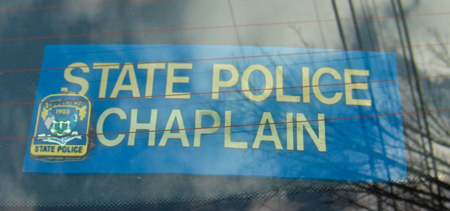 Current CSP Chaplain placard.
Current CSP Chaplain placard.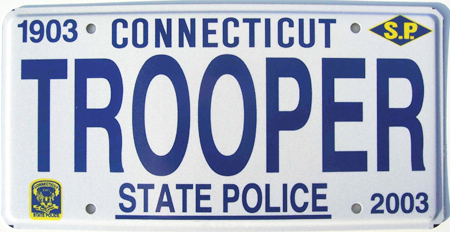 Special Centennial commemorative plate commissioned by CSP Association. Not an official issue. This plate was given to all CSP personnel who attended the 100th Anniversary Ball in 2003 at the Mohegan Sun Casino in Uncasville, CT.
Special Centennial commemorative plate commissioned by CSP Association. Not an official issue. This plate was given to all CSP personnel who attended the 100th Anniversary Ball in 2003 at the Mohegan Sun Casino in Uncasville, CT. 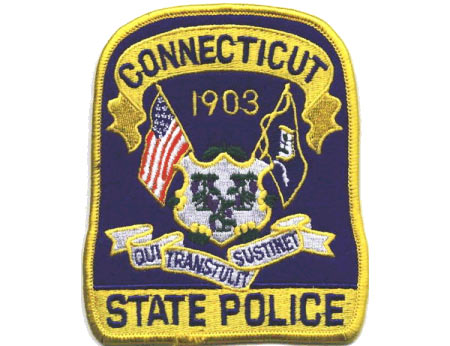
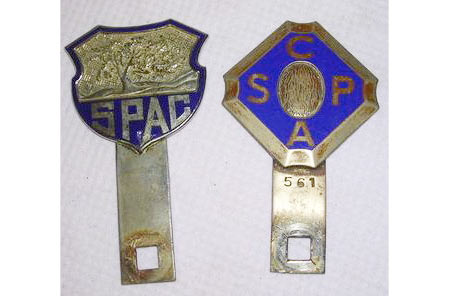 Circa early 1950's. License plate attachment for State Police Association of Connecticut.
Circa early 1950's. License plate attachment for State Police Association of Connecticut.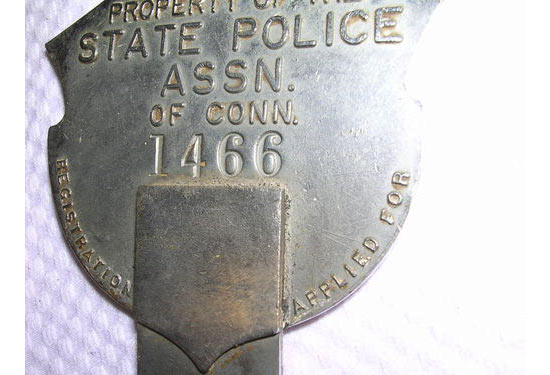 Circa early 1950's. License plate attachment for State Police Association of Connecticut. Backside of SPAC attachment seen above at far left.
Circa early 1950's. License plate attachment for State Police Association of Connecticut. Backside of SPAC attachment seen above at far left.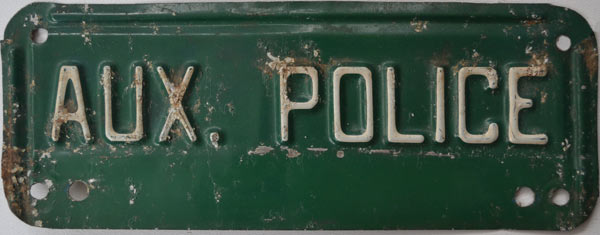 Auxiliary Police "topper". Embossed aluminum. White over green. Primarily used by local and municipal auxiliary police officers, but possibly also by CSP Auxiliary members.
Auxiliary Police "topper". Embossed aluminum. White over green. Primarily used by local and municipal auxiliary police officers, but possibly also by CSP Auxiliary members.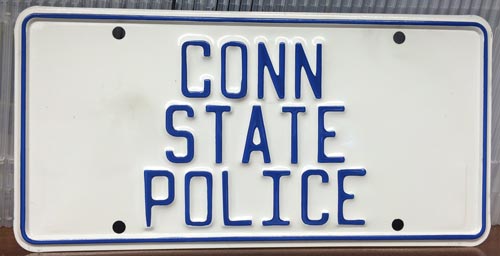 Special type for CSP Auxiliary.
Special type for CSP Auxiliary. 2008 Souvenir issue.
2008 Souvenir issue.As with most state police agencies in the early years, patrol on motorcycle by the CSP in those early motoring days was quite prevalent. Early photographs indicate the use of random Connecticut motorcycle license plates every year, mostly in three digit configurations. Despite this, there is proof of ONE known titled CSP motorcycle license plate that was used in 1929 on the Henderson Excelsior of SPO John Doyle. The 3 inch by 9 inch embossed steel license plate is white on red with STATE over POLICE and no other text inscribed on it. There are no other recorded titled CSP motorcycle license plates known thusfar.
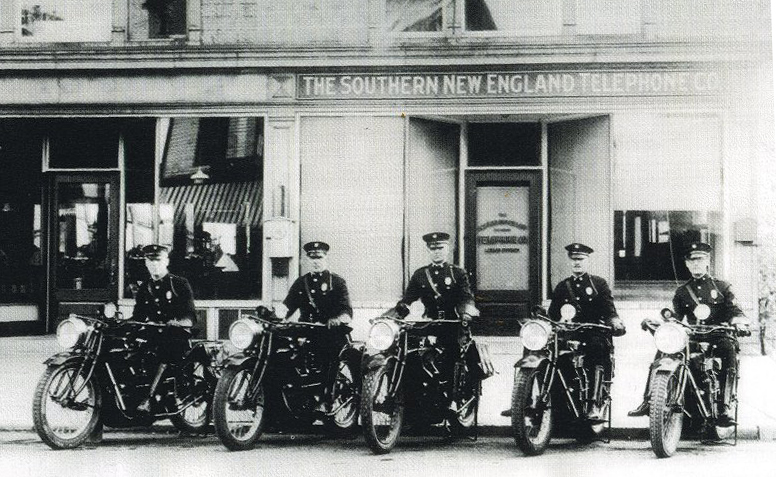
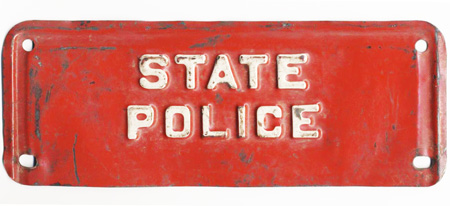 Circa 1929- Embossed steel. Approx. 3" X 9". White over red. Used on the Henderson Excelsior of State Police Officer John Doyle
Circa 1929- Embossed steel. Approx. 3" X 9". White over red. Used on the Henderson Excelsior of State Police Officer John Doyle 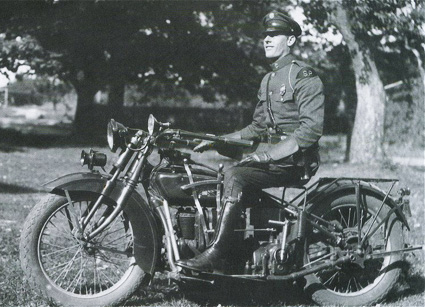
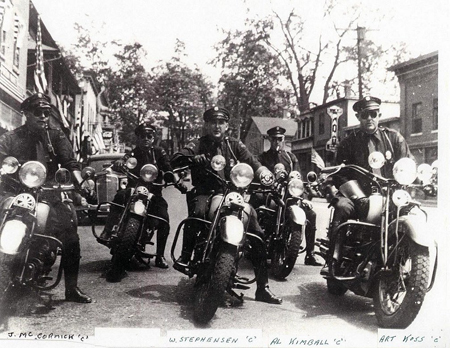
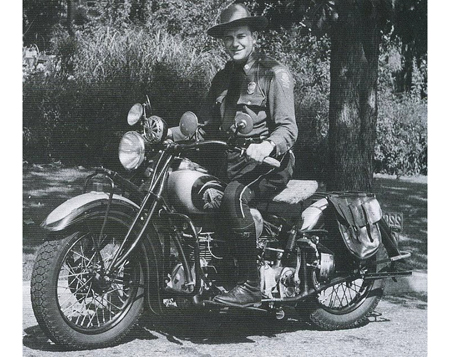
 1960's
1960's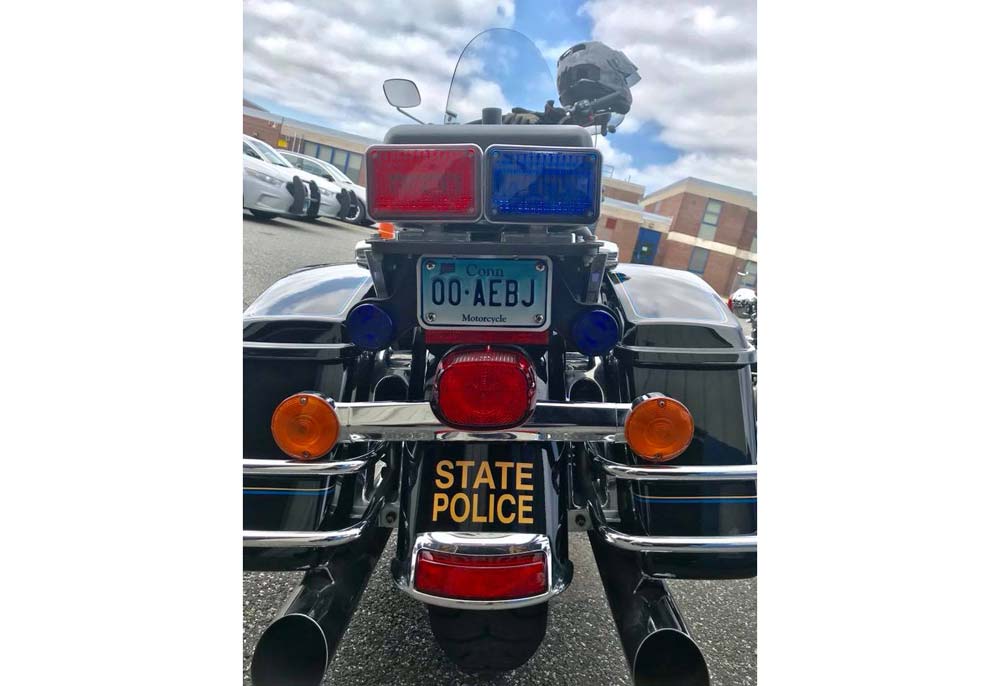 2018.
2018. 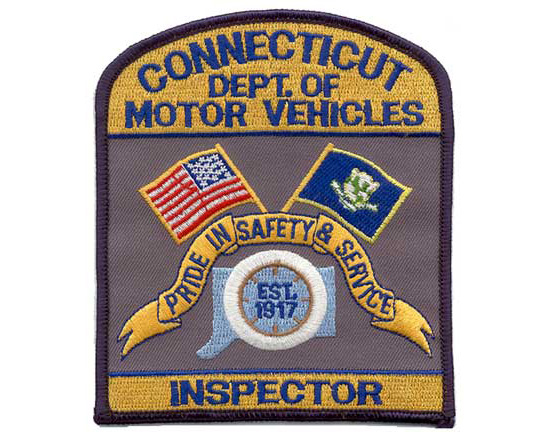
The Connecticut Department of Motor Vehicles was founded in 1917. In 1919 the State Legislature authorized a uniformed force of 30 Inspectors equipped with motorcycles to inspect and weigh trucks on both the New York and Massachusetts borders. Connecticut pioneered the world’s first Point System to control careless and dangerous drivers in 1947, and in 1950 Connecticut was the first to record vehicle engine numbers to track stolen vehicles. Today, Motor Vehicle Inspectors are P.O.S.T. certified (Police Officers Standards and Training) law enforcement officers with powers of arrest. Each Inspector has received hundreds of hours of specialized training and utilizes the latest technologies to assist in DMV’s primary law enforcement functions which include:
Truck safety and size/weight enforcement
School bus inspections and enforcement
Licensing of repairers and dealers of new and used vehicles
Vehicle identification and auto theft investigation
Registration enforcement
Speed and traffic law enforcement
The primary objective of the Connecticut Department of Motor Vehicles, Motor Carrier Safety Assistance Program (MCSAP) is to reduce the number of accidents and hazardous material incidents involving commercial motor vehicles. The Commercial Vehicle Safety Division operates from six fixed weight and inspections sites and patrols all highways and numerous secondary roads throughout the State.
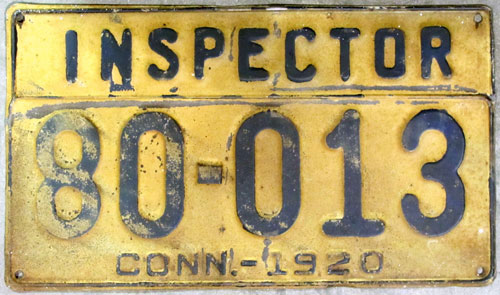 1920 issue Motor Vehicle Inspector. Embossed steel.
1920 issue Motor Vehicle Inspector. Embossed steel.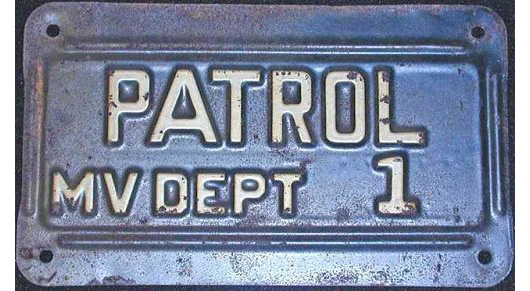 Circa 1946 -1956 issue. Embossed steel. Approx. 4" x 5 1/2".
Circa 1946 -1956 issue. Embossed steel. Approx. 4" x 5 1/2". 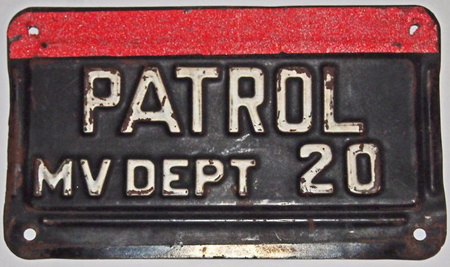 Circa 1950 -1956 issue. Embossed steel.
Circa 1950 -1956 issue. Embossed steel. 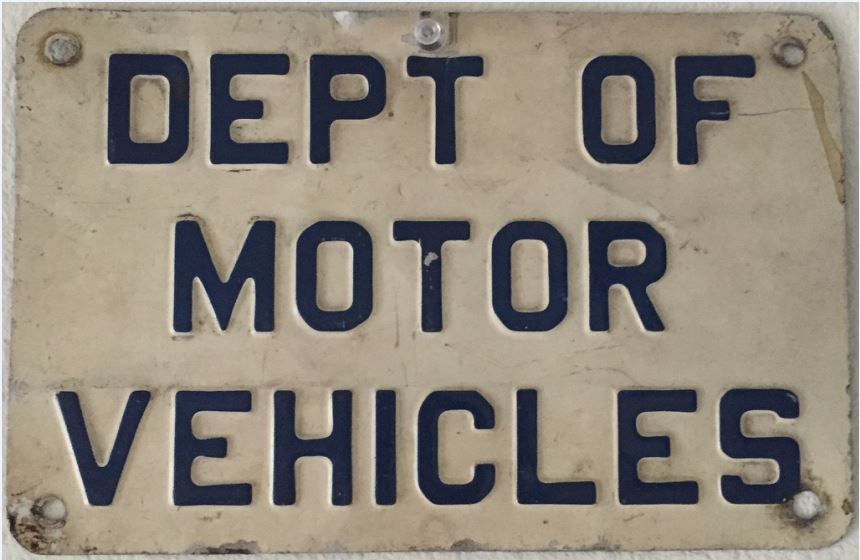 Circa late 1950's. Embossed aluminum.
Circa late 1950's. Embossed aluminum.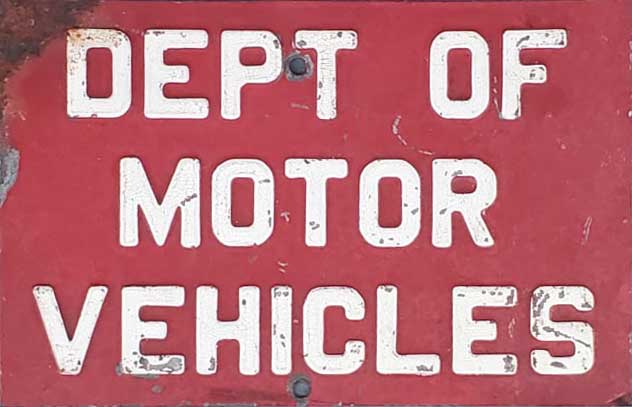 blablba Circa late 1950's.
blablba Circa late 1950's. 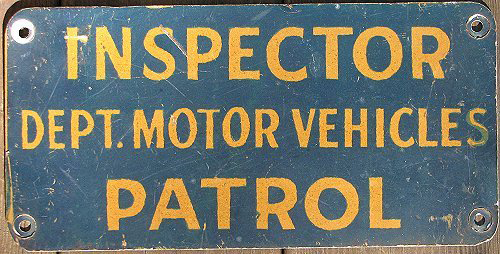 Circa 1950's-1960's issue-
Circa 1950's-1960's issue- 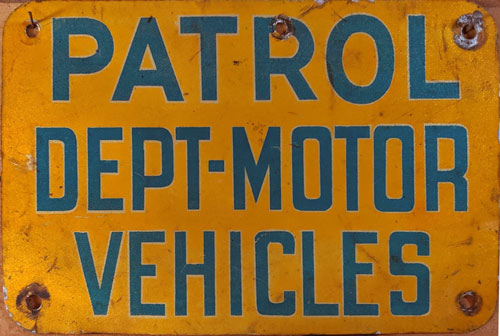 Circa 1960's issue-Flat aluminum. Approx. 6" x 9 1/4".
Circa 1960's issue-Flat aluminum. Approx. 6" x 9 1/4". 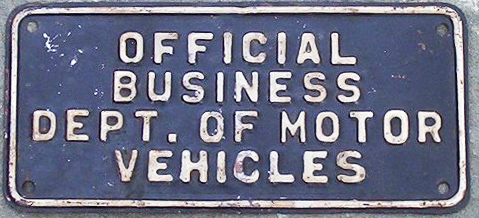 Circa 1960's issue. Embossed aluminum.
Circa 1960's issue. Embossed aluminum.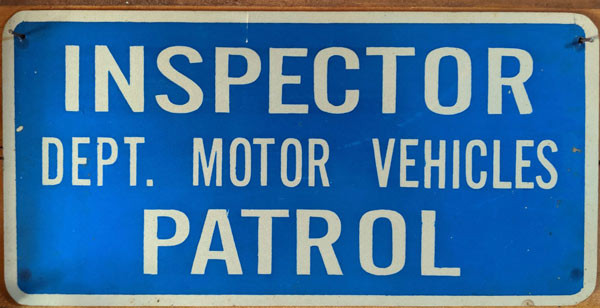 Unkmown date, but more contemporary issue.
Unkmown date, but more contemporary issue.
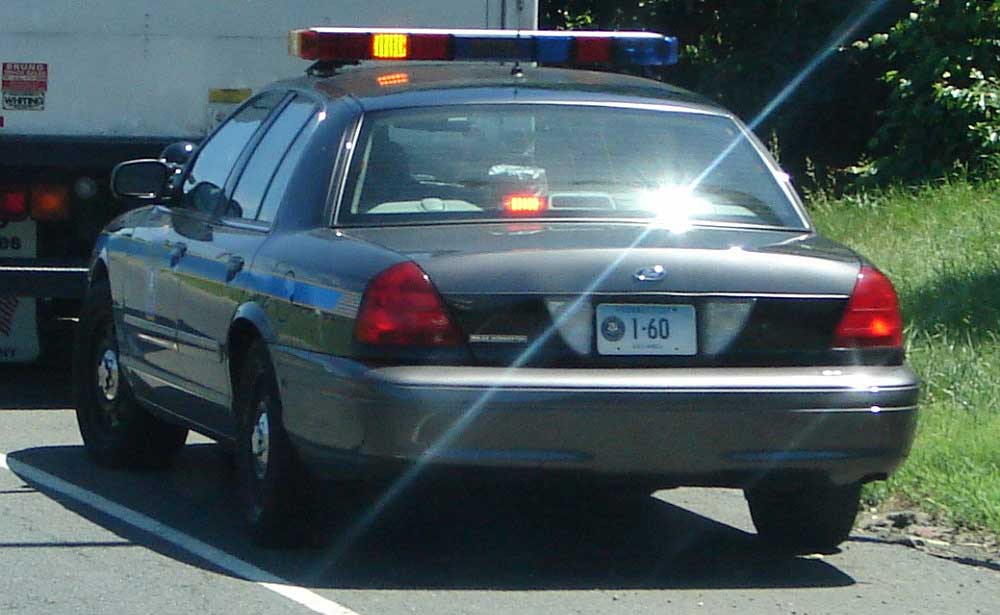 Connecticut MVI use State Vehicle license plates with 1- prefix
Connecticut MVI use State Vehicle license plates with 1- prefix